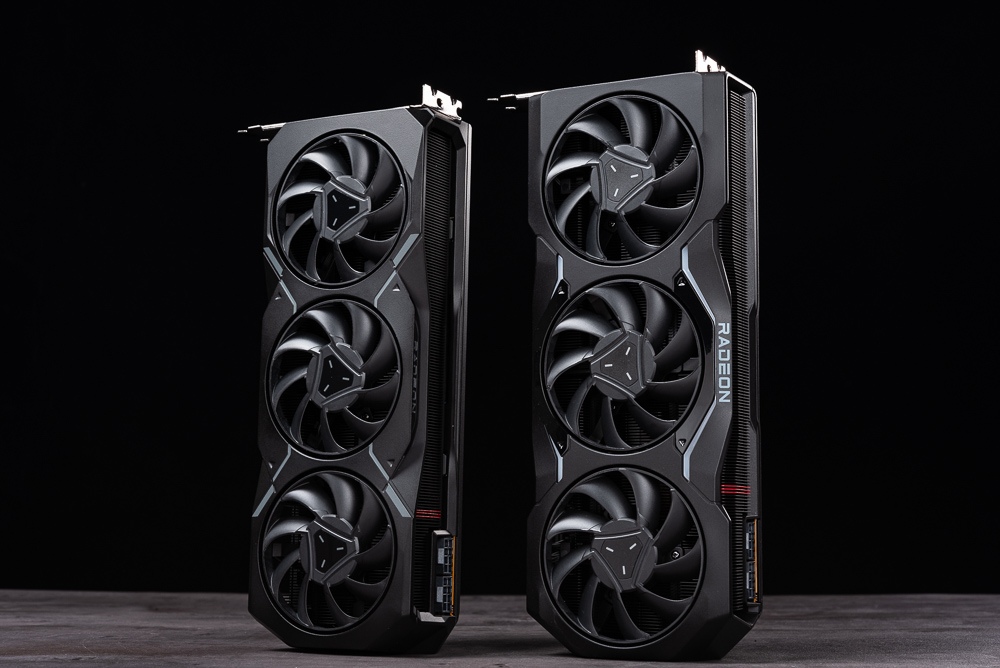
He is a ruthless man! AMD’s new-generation RDNA 3 architecture, Radeon RX 7900 XTX and RX 7900 XT graphics cards, locked in RTX 4080, strive to meet the expectations of players in terms of performance per watt and performance per dollar, and it is also the first chiplet with 5nm GCD + 6nm MCD GPU, upgrade the 2nd generation Infinity Cache, Ray Accelerators, and add AI Accelerators unit and dual media engine, as well as the Radiance Display engine that can fight the future, whether this generation can “4K 100 frames”!
AMD RDNA 3 first battle: Radeon RX 7900 XTX and RX 7900 XT
AMD RDNA 3 is the first GPU with Chiplet small chip packaging technology, inheriting the experience of Ryzen and EPYC processors to innovate in GPU, allowing AMD to choose the right semiconductor process technology To achieve this performance-per-watt goal. The GPU core GCD uses the most advanced 5nm process to ensure performance and power consumption, while the memory controller and Infinity Cache use the more mature 6nm process to build MCD.
In the first battle, AMD Radeon RX 7900 XTX and RX 7900 XT graphics cards were launched first, targeting flagship players with 4K and 2160p high resolution and aiming at the rival RTX 4080 to strive for leading advantages in “performance per watt” and “performance per dollar”.
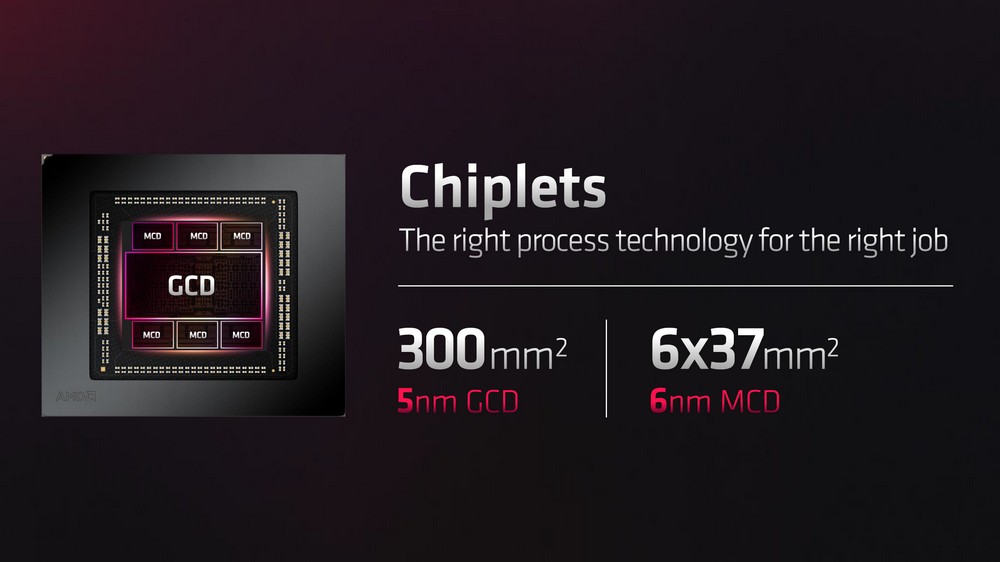
Radeon RX 7900 XTX has 96 sets of CU computing units, 6144 SP stream processors, 96 RA light-chasing acceleration units, 192 AI acceleration units, the clock frequency is from 2300 MHz to Boost 2500 MHz, and 24GB GDDR6 + 96MB Infinity Cache The memory bandwidth can reach 3500 GB/s, the graphics card TBP is set at 355W, and the price is $999.
As for the Radeon RX 7900 XT, there are 84 sets of CU computing units, 5376 SP stream processors, 84 RA light-chasing acceleration units, 168 AI acceleration units, the clock frequency is from 2000 MHz to Boost 2400 MHz, and 20GB GDDR6 + 80MB Infinity Cache allows the memory bandwidth to reach 2900 GB/s, the graphics card TBP is set at 315W, and the price is $899.
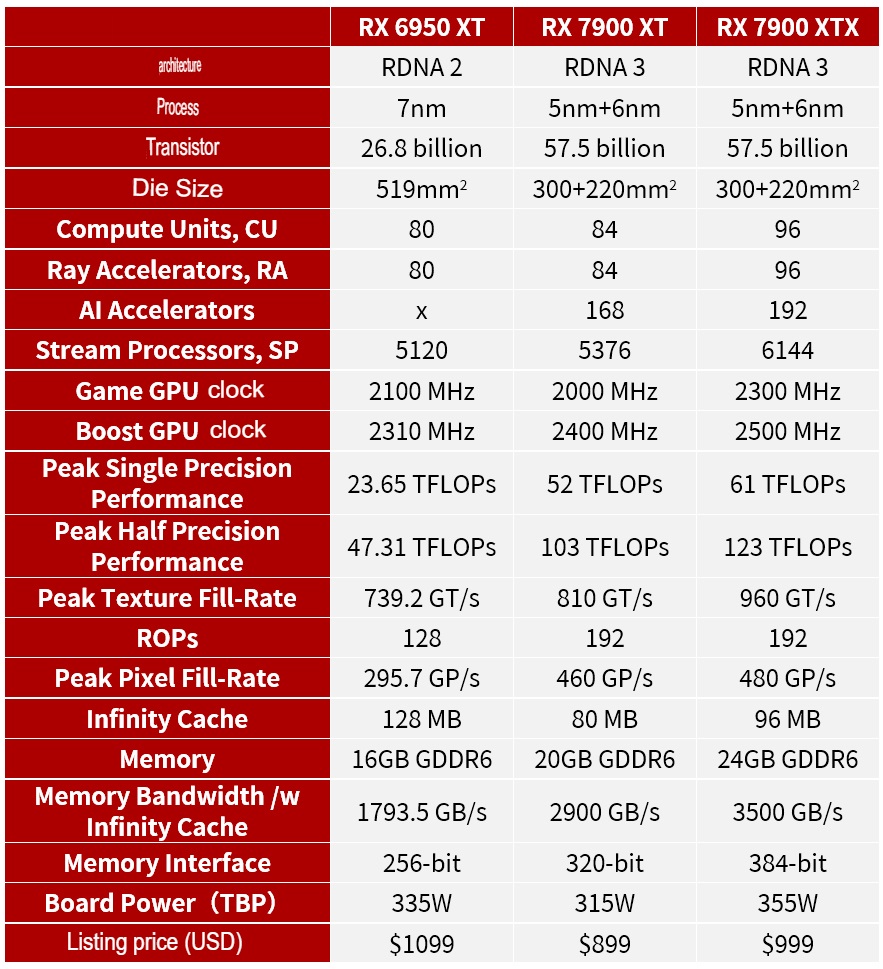
The Graphics Compute Die (GCD) of this RDNA 3 has also been fully upgraded, including a unified RDNA 3 computing unit, a new Display Engine, and a new Dual Media Engine. The new-generation core has a Dual issue SIMD unit, which can double the instruction sending rate and flexibly handle FP, Integer, AI and other operations.
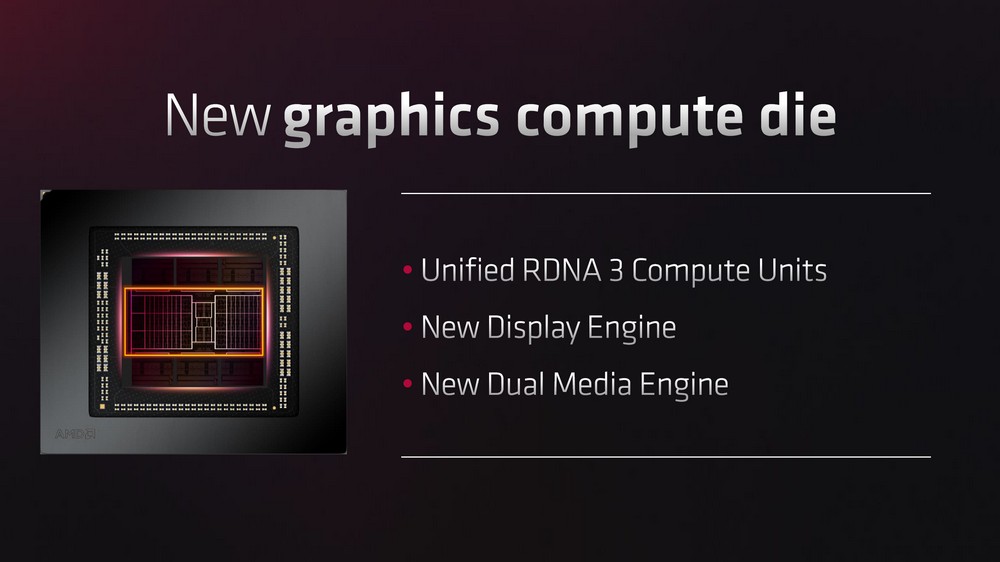
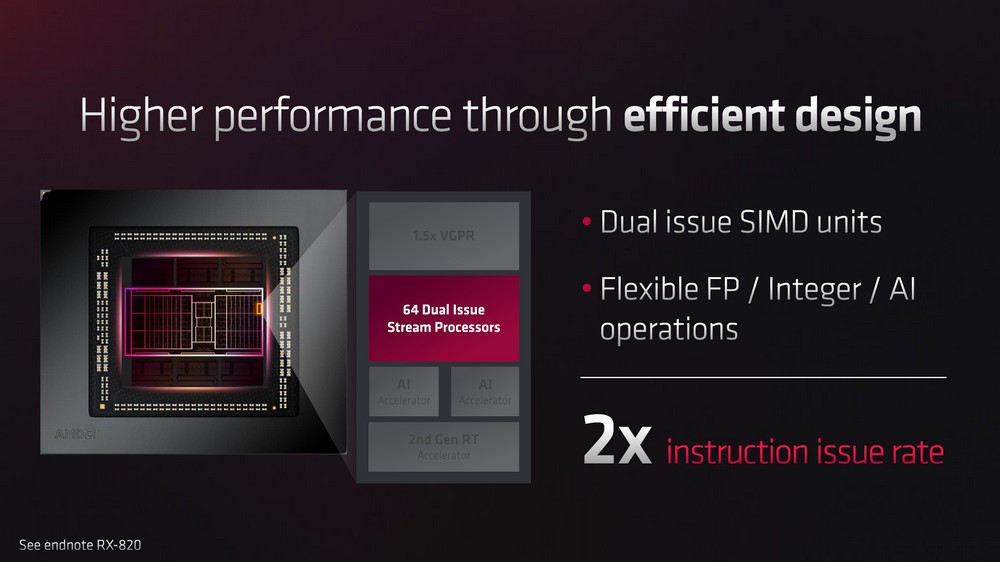
Of course, AI accelerators are newly added. Each CU computing unit has 2 AI acceleration units, which can bring a 2.7x improvement in AI performance. The second-generation ray tracing acceleration technology can increase the ray tracing performance of each CU by 50%, with newly designed instructions, Ray Box Sorting and Traversal.
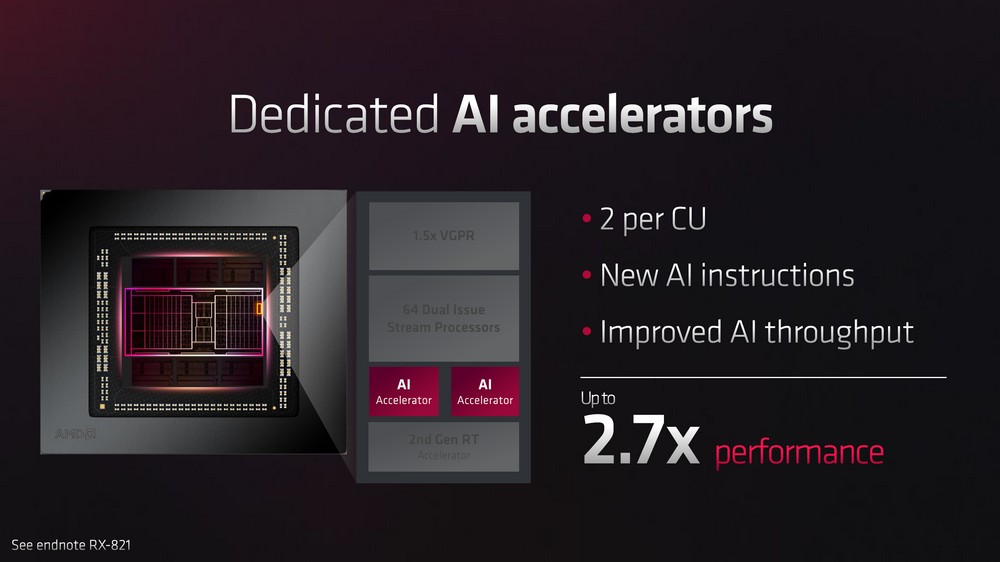
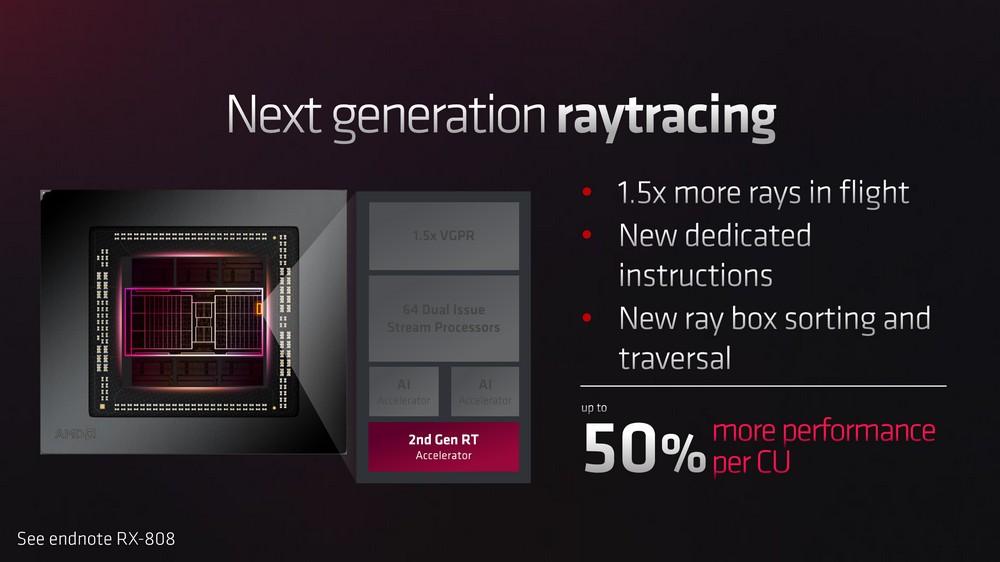
The Memory Cache Die (MCD) includes a 64-bit memory controller and the second generation of Infinity Cache. It can achieve a 2.7x bandwidth increase by connecting to the GCD through the Infinity Fabric. The total memory bandwidth can reach 5.3 TB/s.
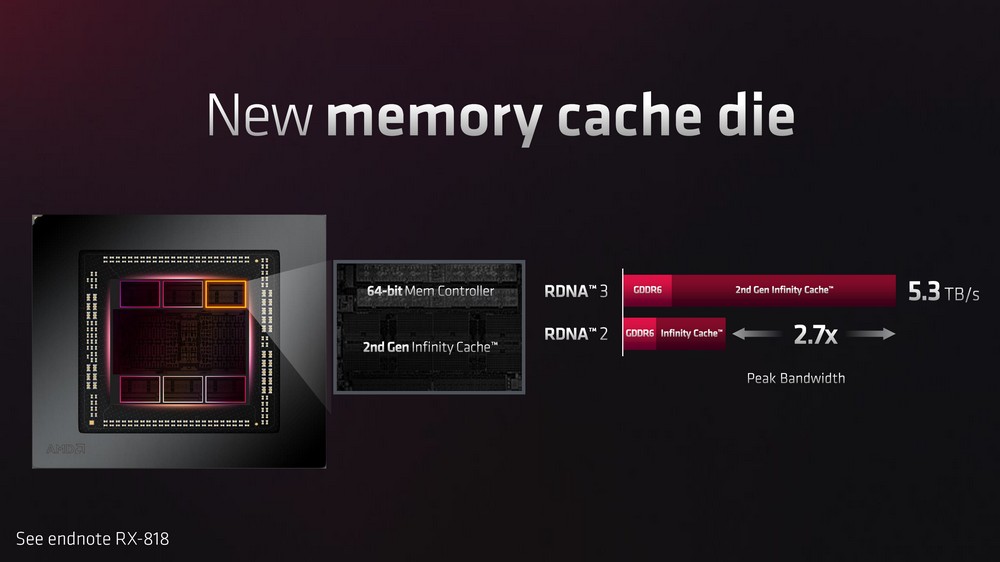
In addition, RDNA 3 will use Decoupled Clocks, which means that the front-end of the GPU has a higher 2.5GHz clock rate, which can process instructions and command distribution faster. At the same time, the GPU Shader runs at 2.3GHz to maintain high energy efficiency. Frequency can save 25% of power consumption and 15% of the clock frequency increase.
In the end, the Raw computing performance of RDNA 3 can be improved by 2.7 times compared with the previous generation RDNA 2. The floating-point computing performance has improved to an astonishing 61 TFLOPS.
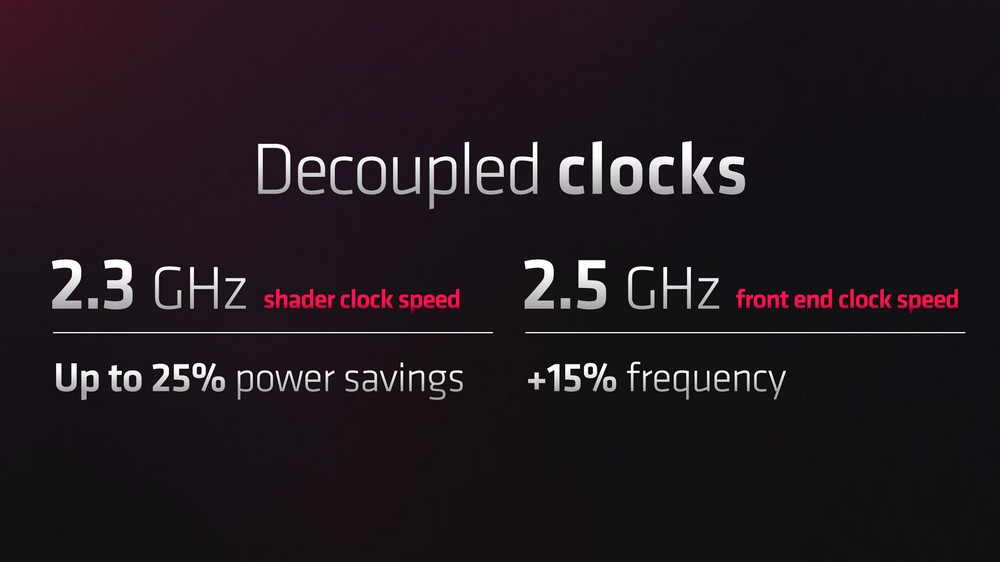
Dual Media / Radiance Display Engine for the Future War RX 7900 Series with HDMI 2.1a and DP 2.1 Output
In this wave of strategies, AMD uses the “future support” feature to strengthen the advantages of its own RX 7900 series. The new AMD Radiance Display engine in the RDNA 3 architecture will support the industry’s latest DisplayPort 2.1 display output specifications and bandwidth. It can reach 54 Gbps and light up ultra-high specifications of 8K165Hz and 4K480Hz.
And this generation uses dual media engines. In addition to the original AVC / HEVC codec, it also adds AV1 encoding and decoding functions to support up to 8K60Hz and AI-accelerated audio and video encoding functions. Still, the mainstream audio and video editing tools Premiere Pro and DaVinci Resolve are not natively supported yet.
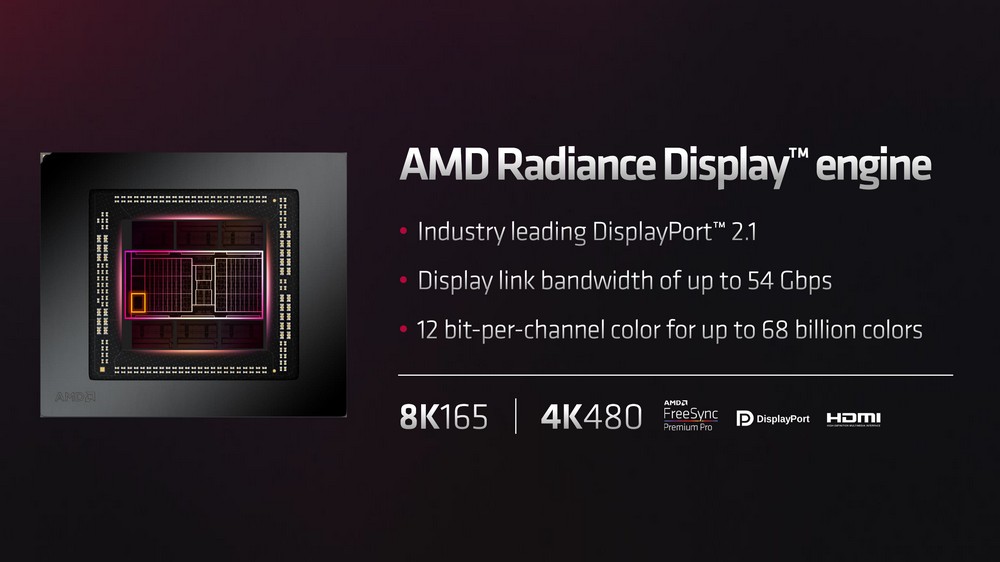
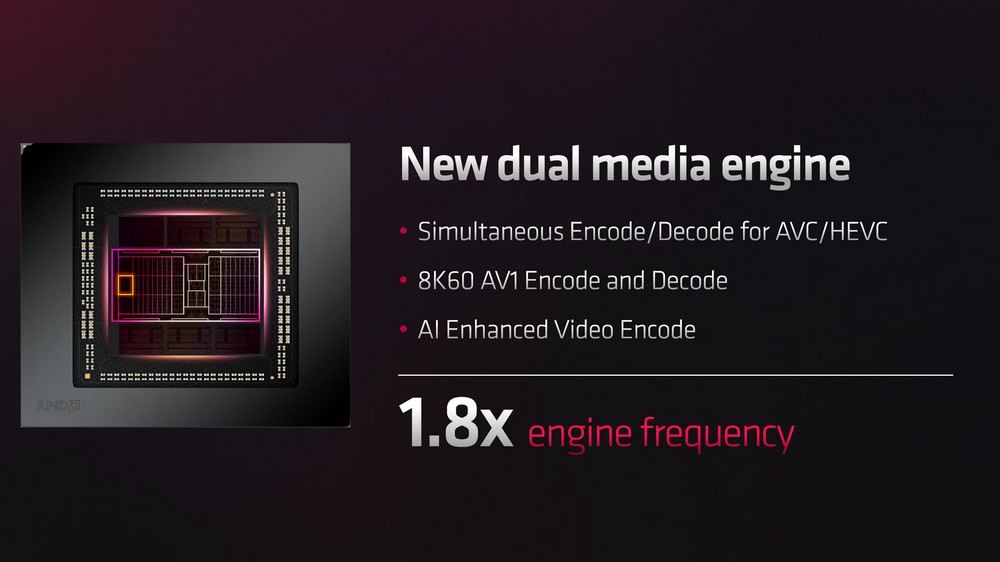
Compared with RTX 4080, RX 7900 series has 24GB 384-bit GDDR6 memory in RX 7900 XT and 20GB 3200-bit GDDR6 memory in RX 7900 XT, which are compared with RTX 4080 16GB 256-bit GDDR6X configuration. Give more video memory.
The audio and video encoding/decoding functions are the same. Still, the RX 7900 series display output has DisplayPort 2.1 and USB-C output functions, and the future specifications can reach up to 8K165Hz and 4K480Hz. The relative RTX 4080 only has 4K240Hz and 8K60Hz output capability.
But for the specifications of future displays, the current 4K maximum is only 120Hz. As for the 8K resolution, it is still a bit far away for e-sports and games, so even next year or even after next year, it may not be useful to get DP 2.1 e-sports screens.
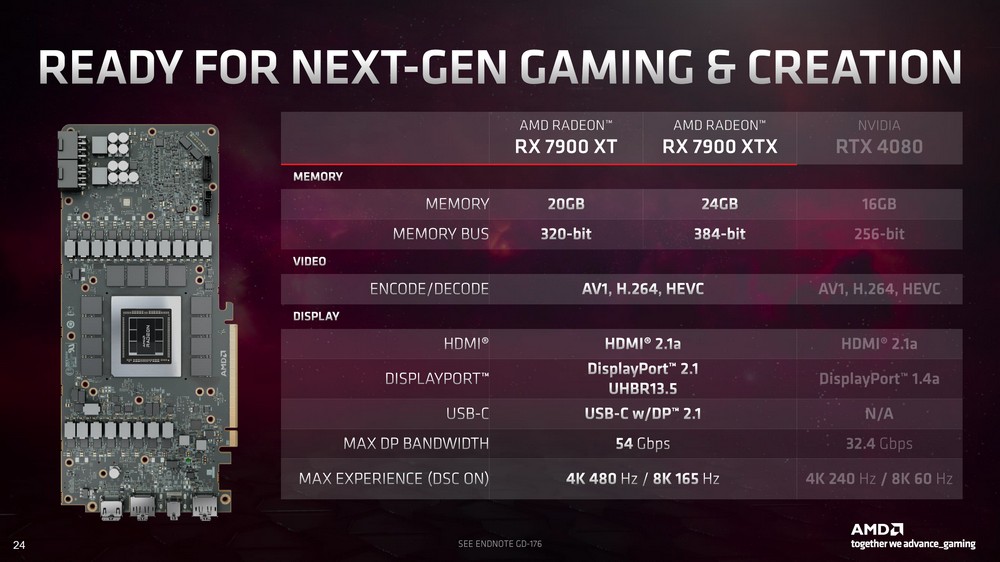
AMD Radeon RX 7900 XTX and RX 7900 XT out of the box/power supply and case do not need to be replaced
Another advantage of upgrading the Radeon RX 7900 XTX and RX 7900 XT is that there is no need to replace the existing power supply and chassis. The size of this generation of AMD’s RX 7900 XTX remains 28.7 cm long and 12.3 cm high, while the RX 7900 XT is long, 27.6 cm and 11.3 cm high. Both occupy 2.5 Slots of space and have dual PCIe 8-pin power supply, but the partner’s custom card may not be so easy to say.
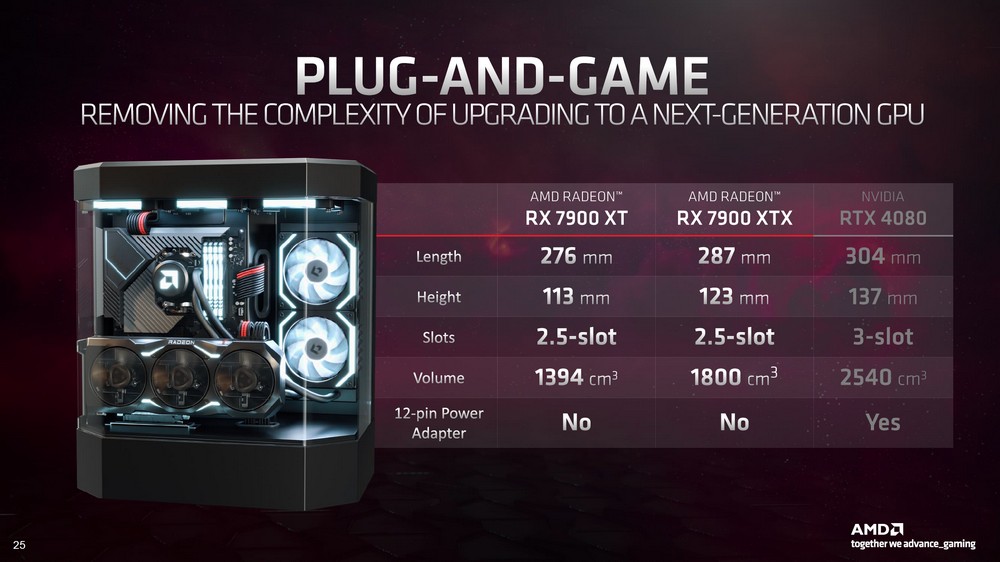
This generation of AMD Radeon RX 7900 XTX and RX 7900 XT graphics cards maintain a low-key black and handsome shape and even paint the 3 cooling fins with bright red accents, while the RX 7900 XTX has a white LED backlight and Both are equipped with the classic design of 3 axial fans.
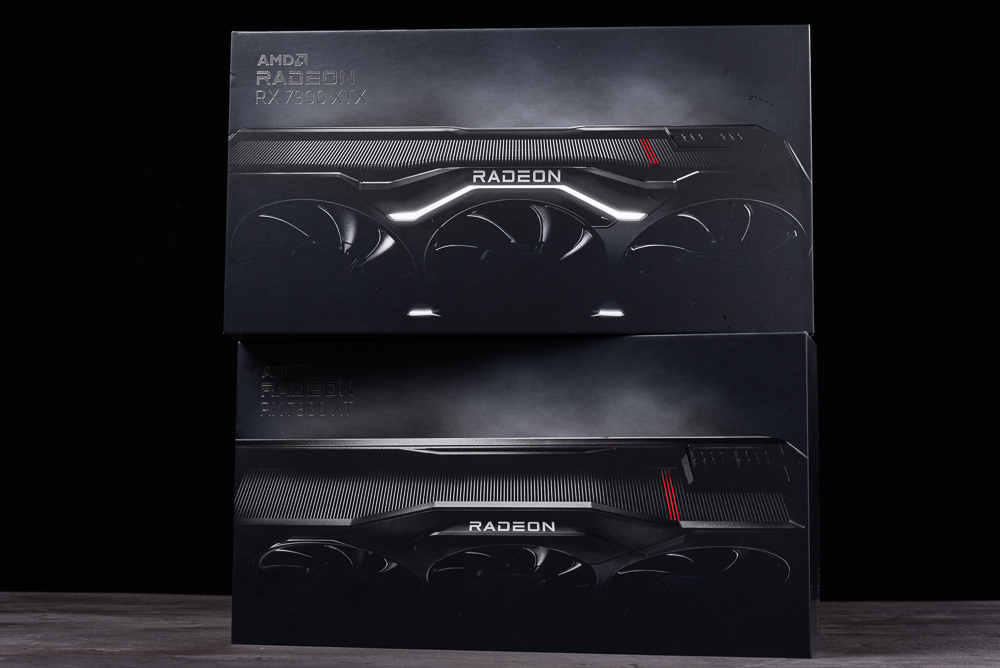
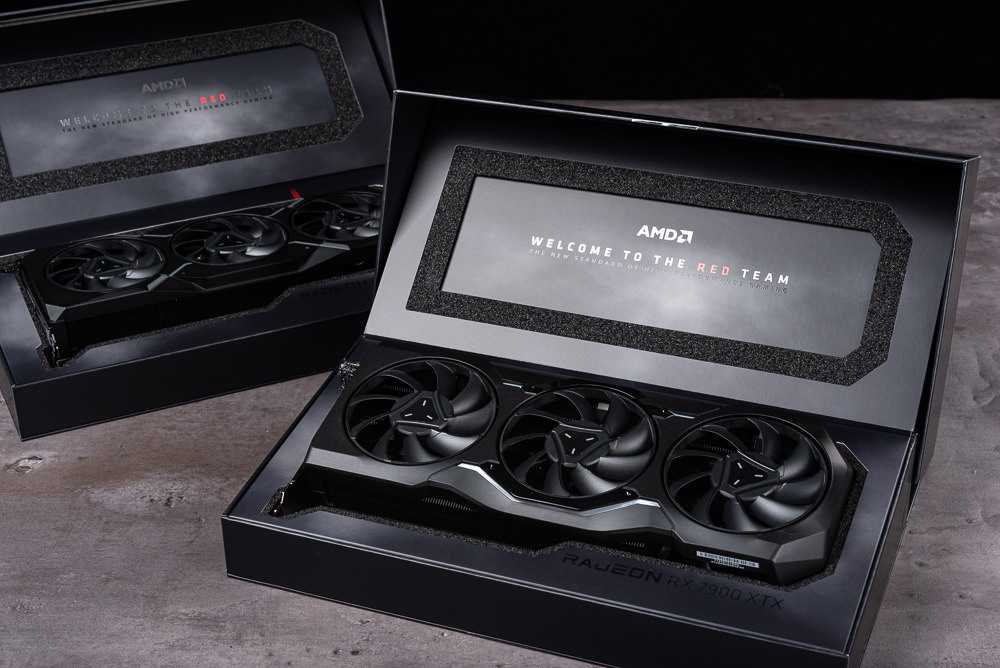
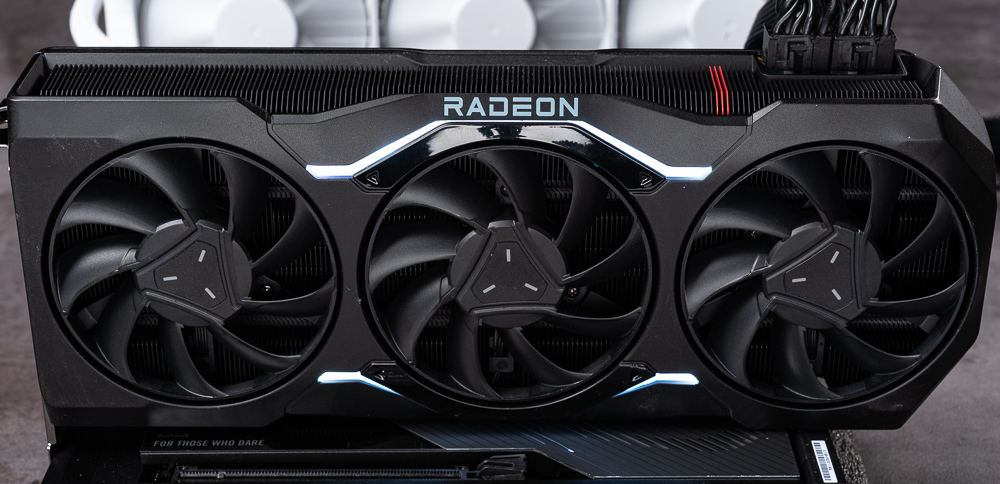
AMD Radeon RX 7900 XTX and RX 7900 XT graphics cards, this generation has changed to a blackened, low-key multi-line shape, which makes the whole look more black and technological, and there are 3 axial fans on the front and full-scale cooling fins on the side Slim design with redfin accents.
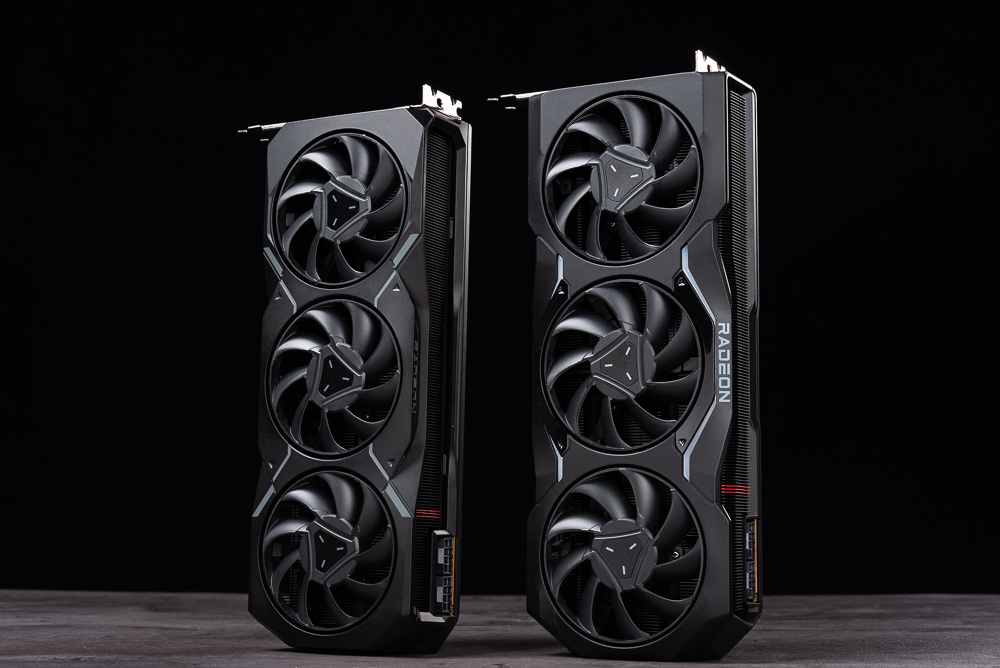
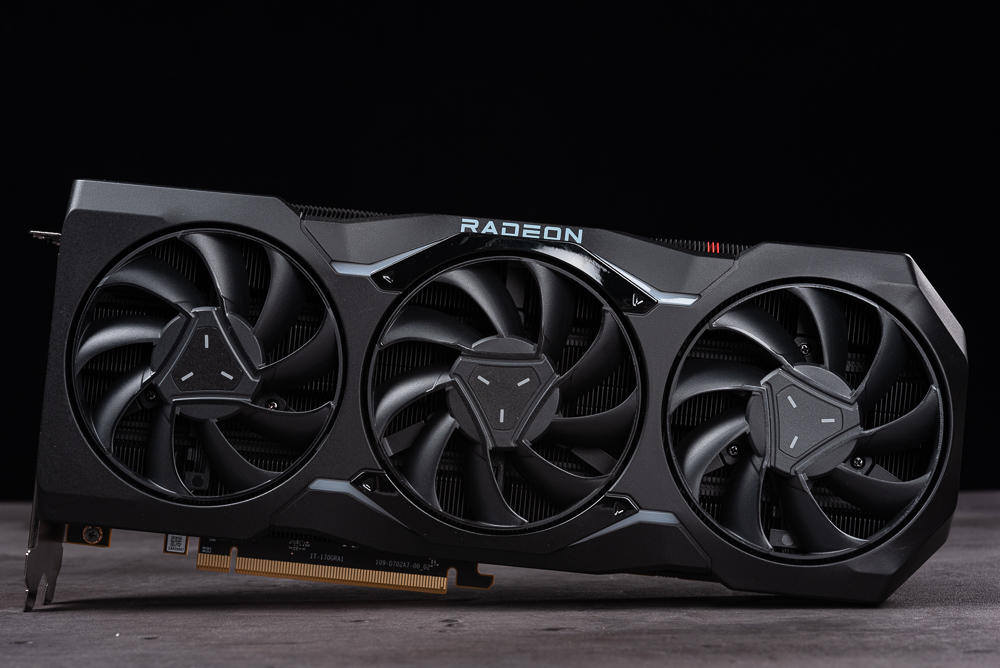
The top side of the graphics card is full of heat dissipation fins, and 3 heat dissipation fins are decorated with red, which is a bit similar to the colour jumping decoration of the radiator cover of a car.
The RX 7900 XTX and RX 7900 XT only need two PCIe 8-pin power supplies, and there is no need to upgrade the power supply for the graphics card.
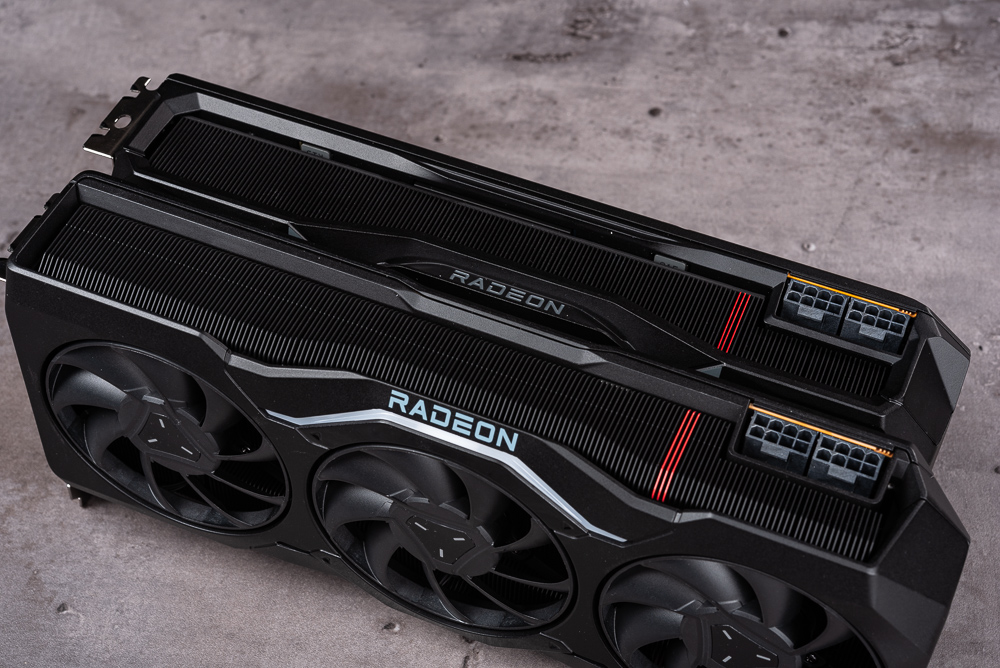
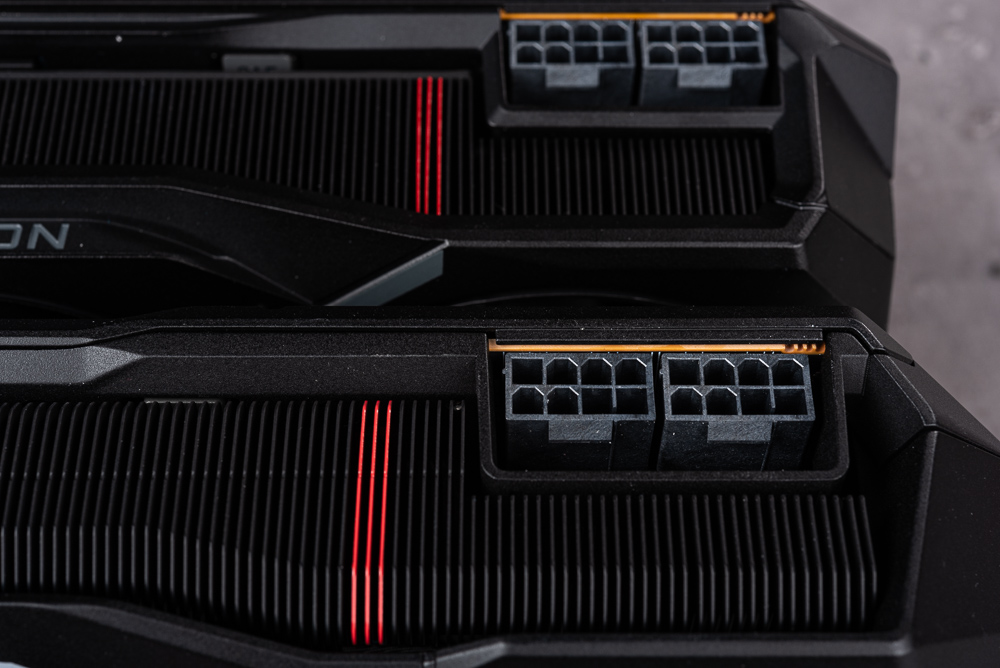
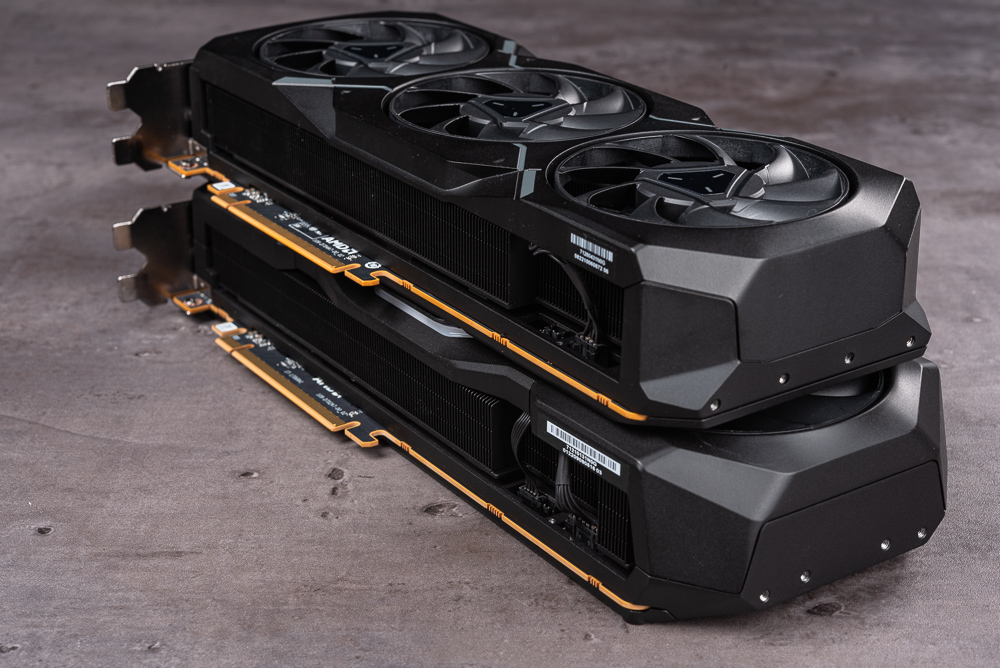
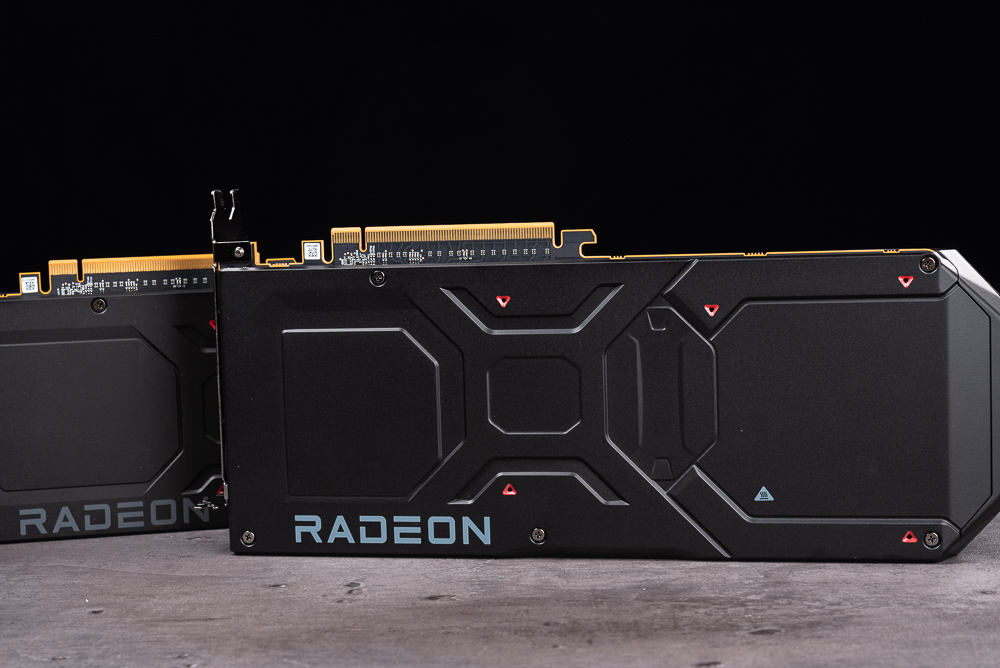
In terms of display output, it provides 1 HDMI 2.1a, 2 DisplayPort 2.1, and 1 USB-C DisplayPort 2.1 ports for a total of up to 4 screen outputs; however, currently, gaming screens are mainly DisplayPort and HDMI, while USB-C is more Appears on commercial monitors that support Thunderbolt. If players need 4 screen outputs, they must buy a USB-C to DisplayPort cable.
The USB-C specification is USB 3.2 Gen 1 with a transmission capability of 10Gbps.
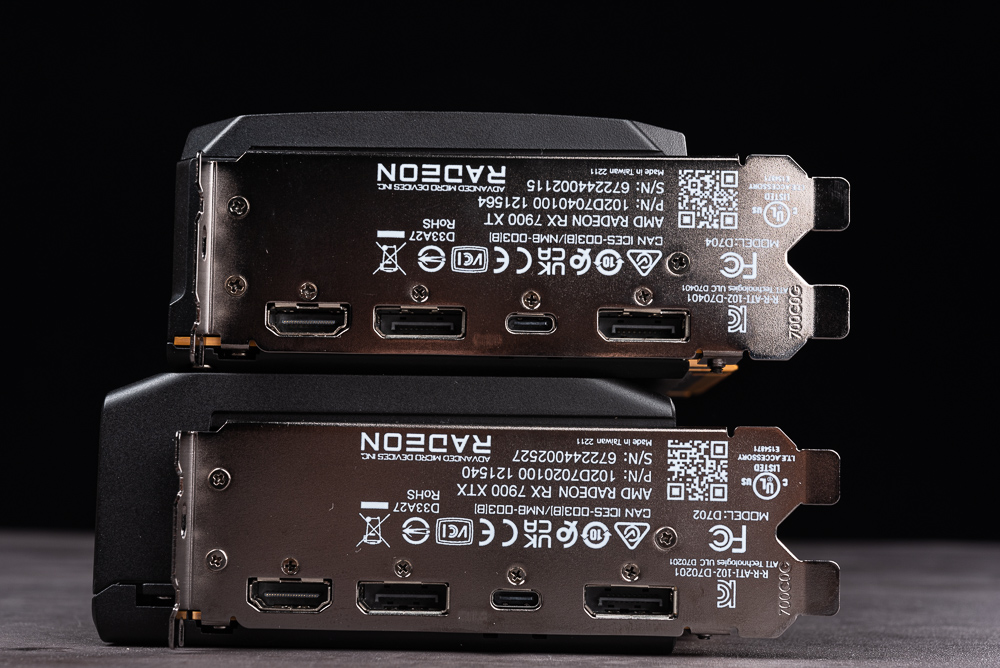
AMD Radeon RX 7900 XTX and RX 7900 XT creative audio-visual output, GPU rendering performance test
This test includes creation tests such as Adobe Premiere Pro 2020, DaVinci Resolve 18 and SPECview. Games are tested at 2160p, 1440p resolution and special effects fully open, the performance of AAA games and ray-chasing games, and related tests of DLSS 3, while comparing the RTX 4080 and the previous generation RX 6950 XT so that players have more data references.
Test Platform
Processor: AMD Ryzen 9 7900X
Motherboard: ASUS ROG CROSSHAIR X670E HERO
Memory: G.SKILL TRIDENT Z5 NEO DDR5-6000 16GBx2
Graphics Card: AMD Radeon RX 7900 XTX, AMD Radeon RX 7900 XT, NVIDIA GeForce RTX 4080 Founder’s Edition, ASRock Radeon RX 6950 XT OC Formula
System Disk: Solidigm P41 Plus 1TB PCIe 4.0 SSD
Cooler: Phanteks Glacier One 360MPH
Power Supply: Seasonic PRIME PX-1000
operating system: Windows 11 Pro 21H2 64bit, Resizable BAR On
driver version: AMD 22.40.00.57, NVIDIA 527.37
GPU-Z has not been able to view AMD Radeon RX 7900 XTX and RX 7900 XT information, using Navi 31 GPU, There are 6144 and 5736 rendering SP cores, respectively, and 24560 MB GDDR6X (Hynix), 20464 MB GDDR6X (Hynix) memory, and the GPU preset clocks are 2269 MHz and 2025 MHz, and the Boost clock can reach 2499 MHz.
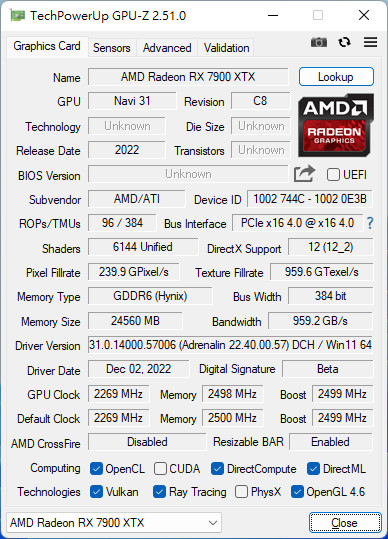
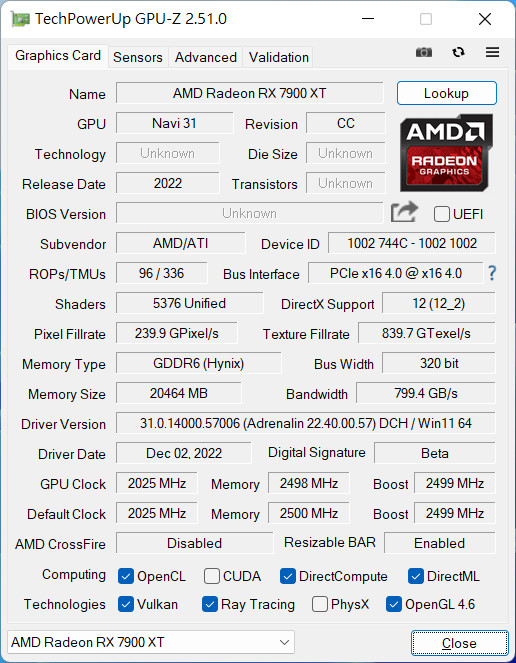
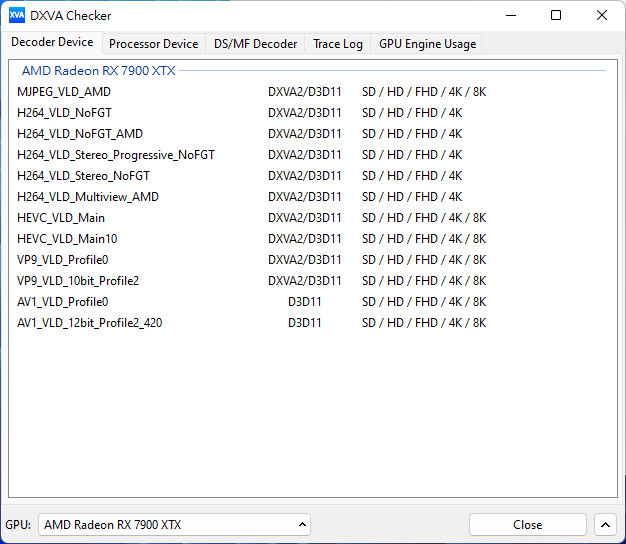
Adobe Premiere Pro 2022The video and audio editing software are accelerated by the self-developed Mercury Playback Engine GPU, which can accelerate the video output speed with the help of the GPU encoding engine. The project used in the test is the company’s 1080p60fps out-of-the-box video, and the BigMix4K project uses three FinalAdjusted_MPE 1920×1080 images to form a 4K timeline for H.264 and HEVC format output.
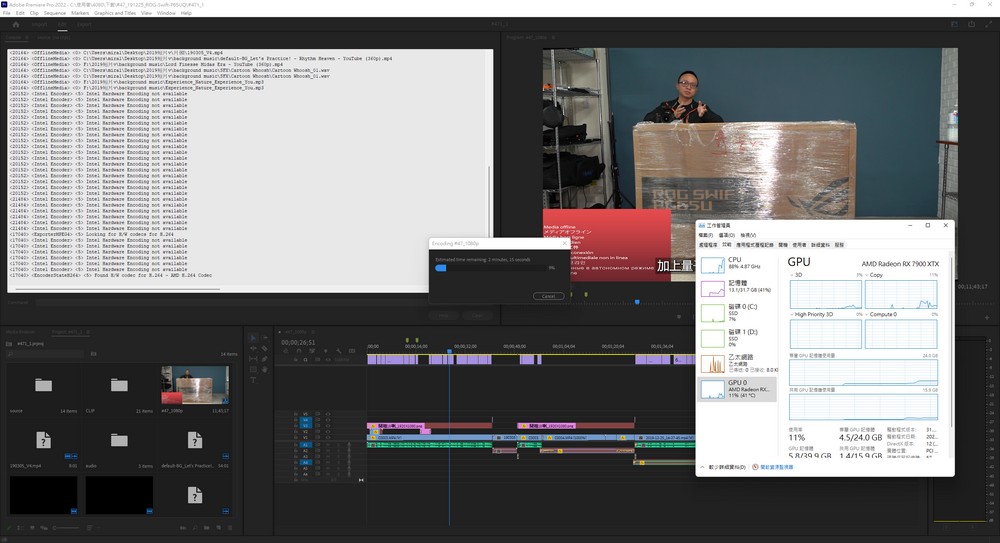
(The tested Premiere Pro 2022 does not yet support the RX 7900 series and RTX 4080 dual-encoding function.)
Since Premiere Pro 2022 does not yet support dual-encoding engines, this performance is for reference only, and it will not be tested until future software officially supports it. Out the performance difference between the two.
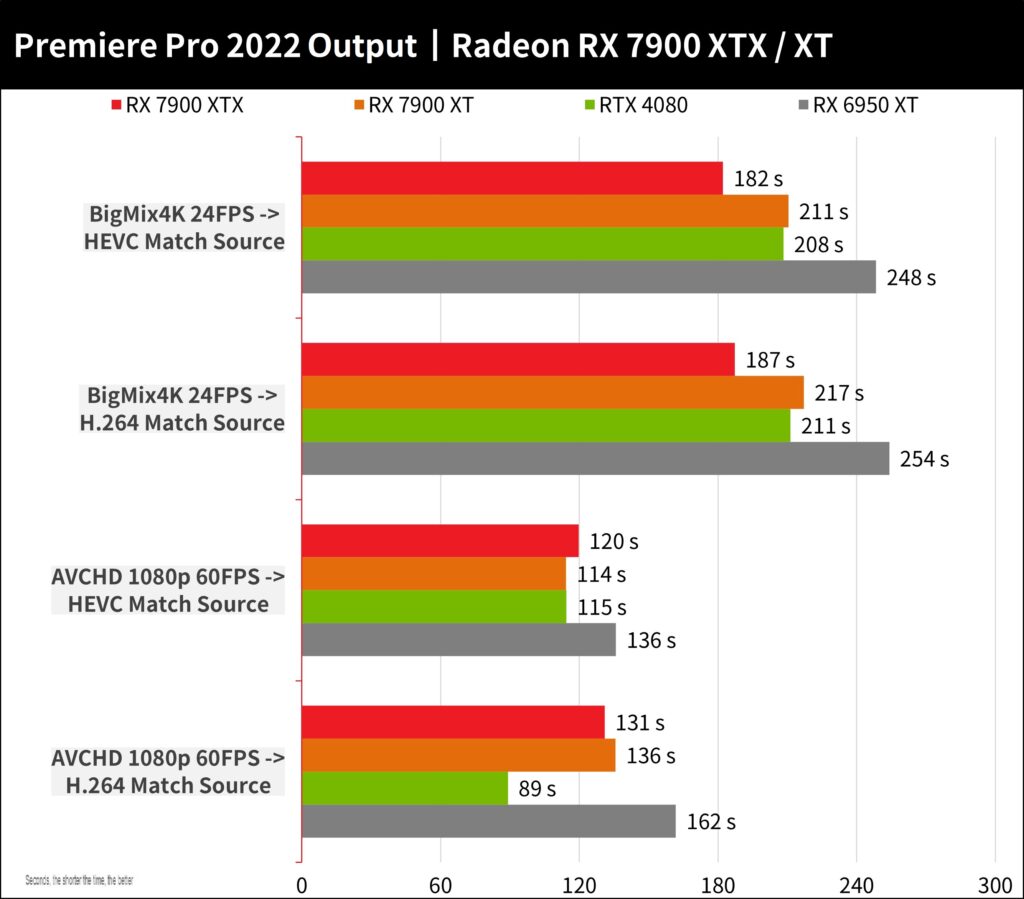
DaVinci Resolve 18 is a purely GPU-accelerated video editing program, including powerful colour correction and special effects functions. It directly uses GPU computing so that the playback and output of video clips have excellent performance. The test version does not yet support AMD RX 7900 series dual encoding and AV1 encoding functions.
First, the first test project uses 4K Blackmagic RAW images and has a Wedding_Heavy_Styles timeline. This video uses a lot of Resolve effects, such as OFX: Light Rays / Glow / Sketch, etc., to output a very high-style video type.
Bride_FaceRefine_Selective_Color uses Face Refinement for face tracking and highlights the main bride with colour; both 50% Retime and Optical Flow Enhanced Better use Optical Flow technology to reduce the image speed by 50%.
SuperScale2x 4K Source uses 4K ProRES source video to produce 4K video output of 2x Zoom In subject; SuperScale4x HD_Source uses HD H.264 source video and uses Resolve Super Scale to output 4K videos.
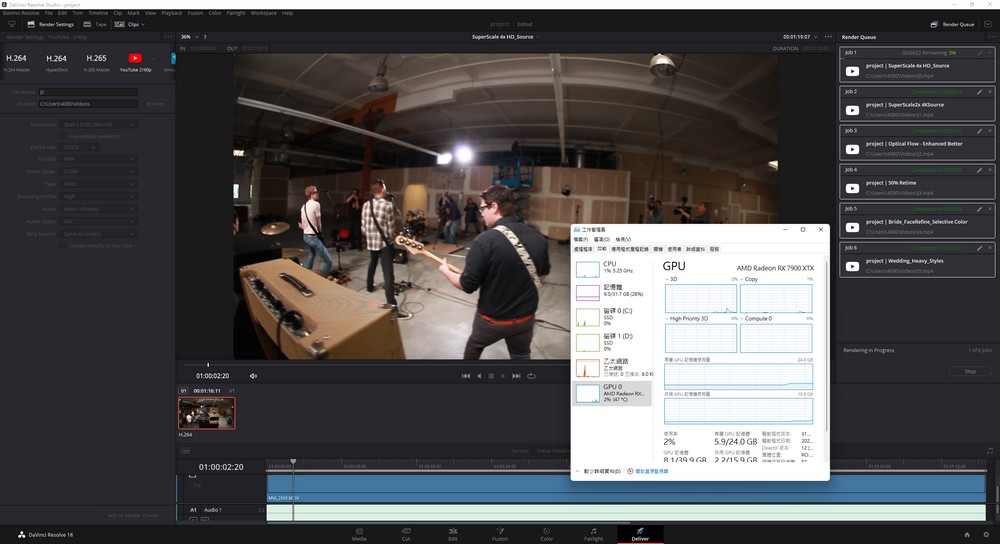
As for DaVinci, Resolve 18 is an audio-visual software that prefers NVIDIA GPU architecture, so RTX 4080 has an absolute advantage in terms of performance. This also needs to wait until future software supports AMD GPU to show this generation’s performance.
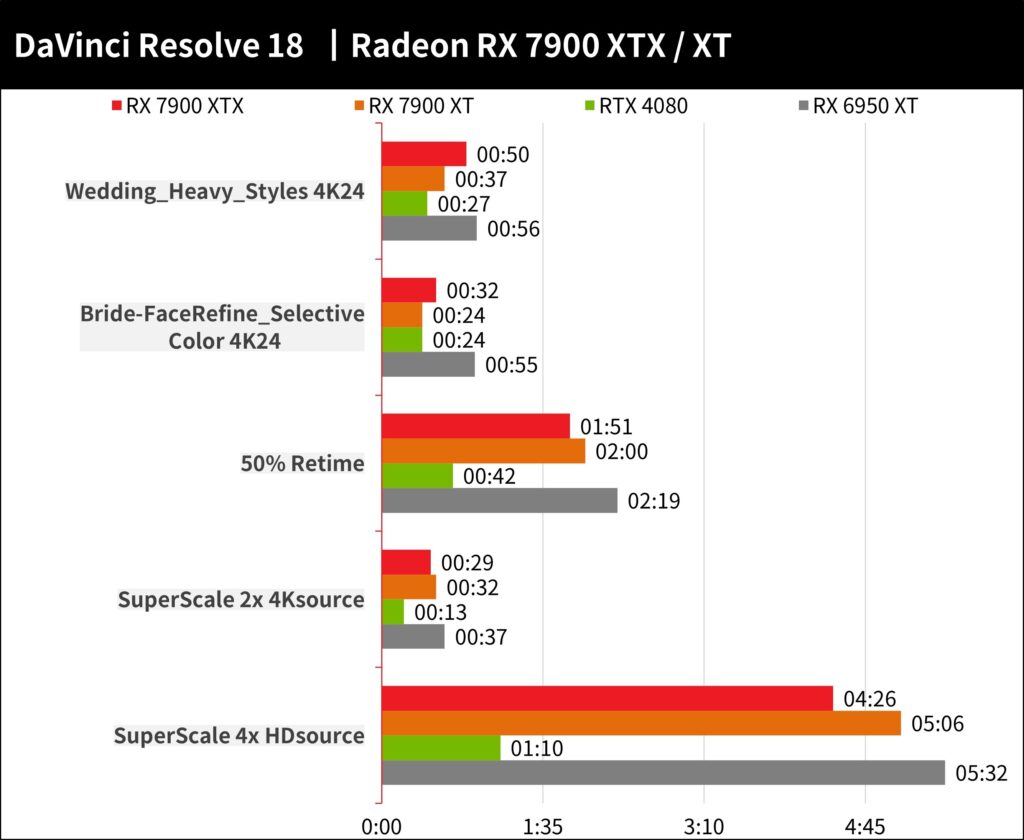
SPECviewperf 2020 is a standard drawing performance test tool developed based on professional applications to test various professional computer graphics software such as 3ds Max, Catia, Creo, Energy, Maya, Medical, SNX, SolidWorks and other drawing tests and engineering simulations.
Tested at 1920 x 1080 resolution and scored in FPS. The performance depends on the tools used. Unexpectedly, RX 7900 XTX and RX 7900 XT have much better results than RTX 4080 in this project test, which is provided for the reference of professional workers.
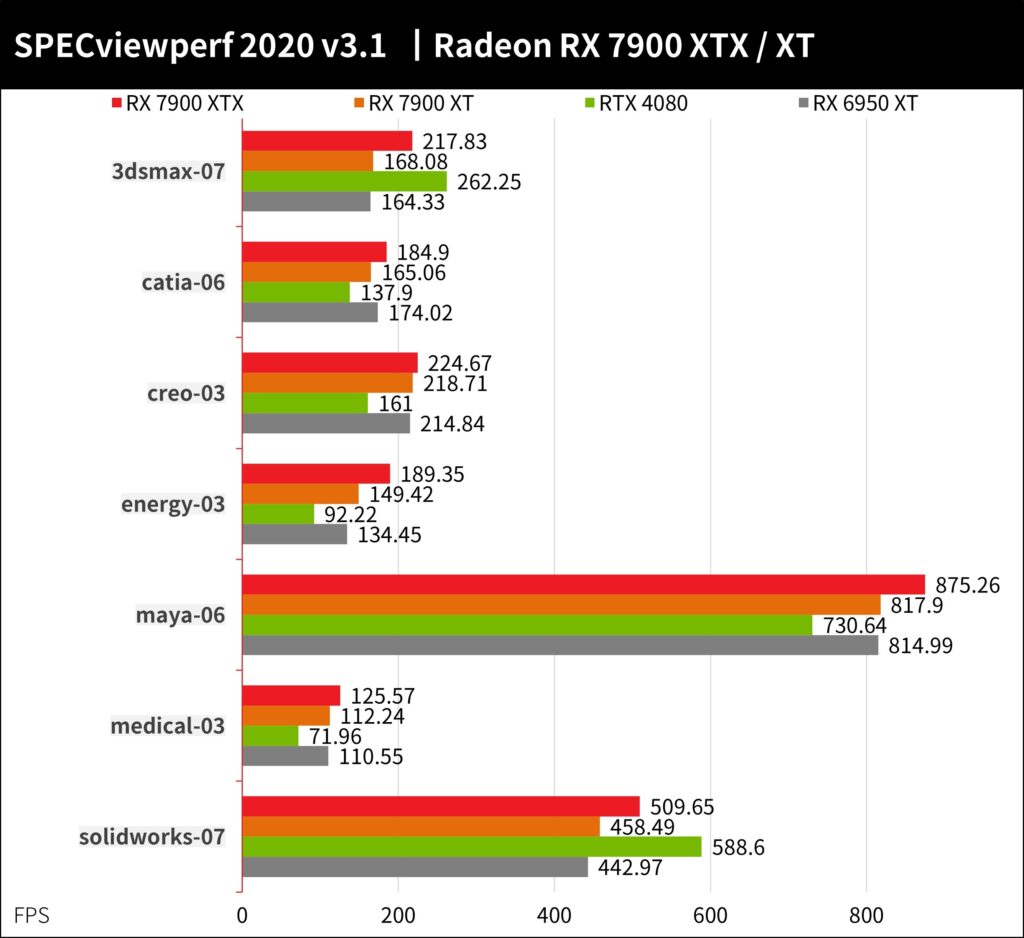
AMD Radeon RX 7900 XTX and RX 7900 XT – 3DMark benchmark performance test
3DMark Fire Strike performance test is a test scenario for the mainstream DirectX 11 API, testing the performance of 1080p, Extreme 1440p and Ultra 2160p, respectively.
The RX 7900 XTX scored 20162 points in Fire Strike Ultra, and the RX 7900 XT scored 17233 points. RX 7900 XTX and RX 7900 XT have 31% and 12% improvement in graphics performance compared to the previous generation RX 6950 XT; compared to RTX 4080, RX 7900 XTX has a 16% performance lead, while RX 7900 XT is a small loss -1% performance.
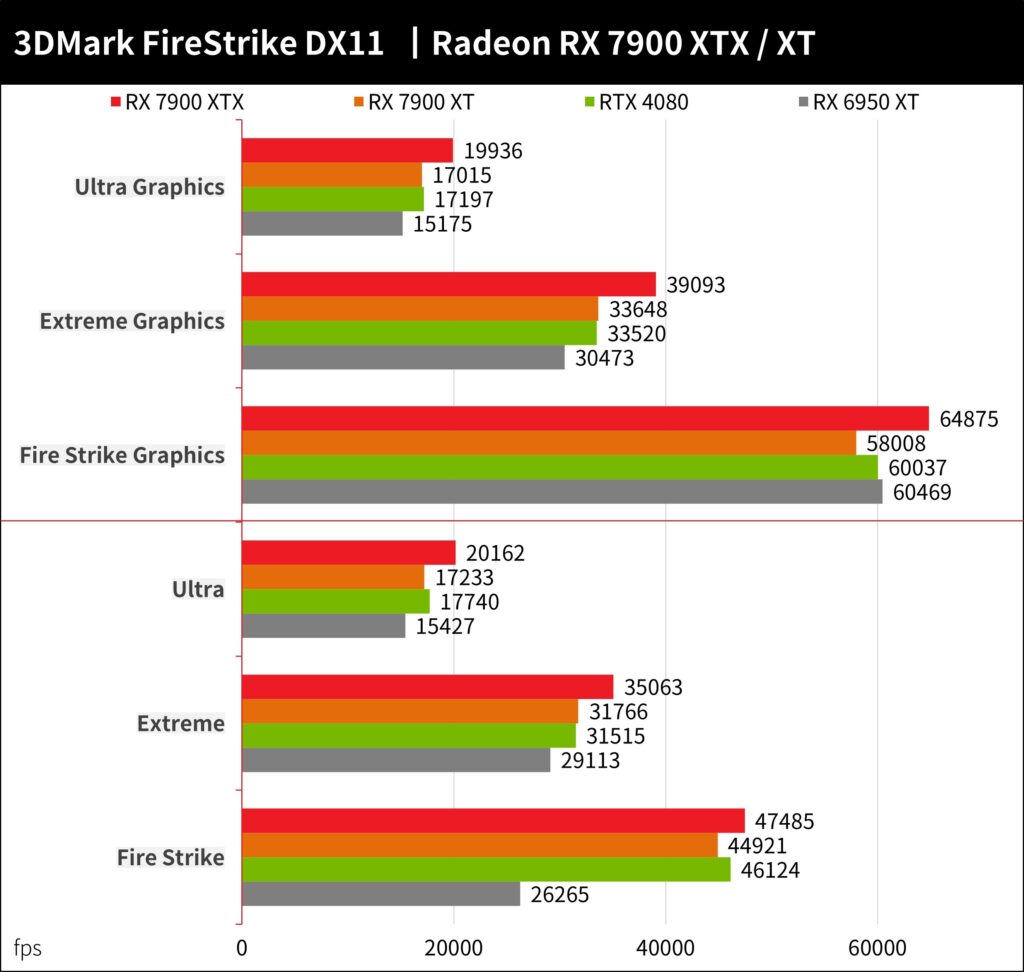
3DMark Time Spy is a test scenario designed using DirectX 12 API, which is also locked at the AAA game level and tests the performance of 1440p and Extreme 2160p, respectively.
The RX 7900 XTX achieved 14574 points in Time Spy Extreme, and the RX 7900 XT scored 12800 points. The graphics performance of RX 7900 XTX and RX 7900 XT is 37% and 18% higher than that of the previous generation RX 6950 XT, respectively; compared with RTX 4080, RX 7900 XTX has a 6% performance lead, while RX 7900 XT is a small loss -9% performance.
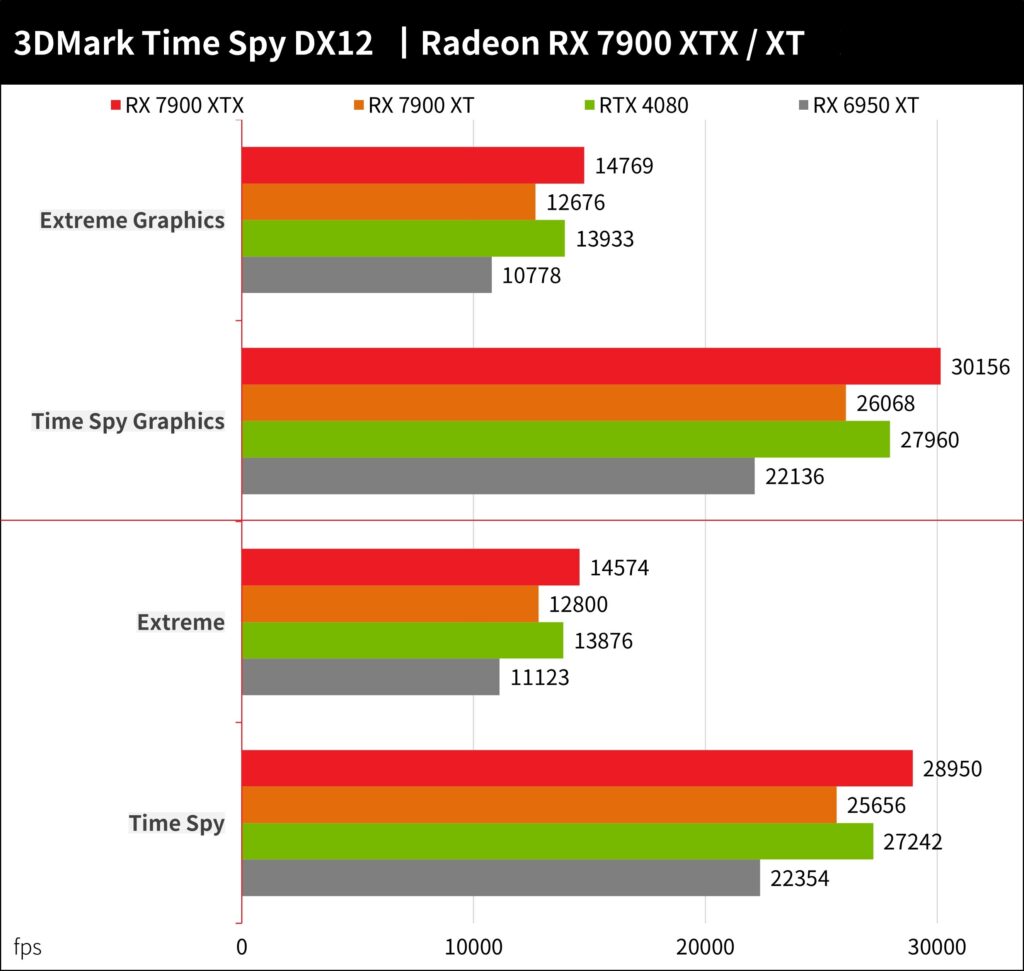
3DMark Ray tracing the test, Port Royal added the ray tracing function to the scene in the AAA game, testing the ability of the new generation GPU to accelerate hardware ray tracing. At the same time, the DXR test is a functional test using the DirectX Raytracing API. The newly added Speed Way includes a new generation of graphics technologies such as real-time light tracing global lighting, ray tracing reflection, and Mesh Shader.
RX 7900 XTX and RX 7900 XT can achieve 60 FPS and 49 FPS performance in Speed Way without FSR acceleration; similarly, Port Royal can also achieve a passing performance of 75 FPS and 64, but AMD is in the DXR test Only 49.84 FPS, 42.91 FPS.
Regarding optical tracking performance, the RX 7900 XTX and RX 7900 XT have an average performance upgrade of 58% and 34% compared to the previous generation RX 6950 XT. But in the face of RTX 4080, they lost -22% and -34%, respectively, in light pursuit performance.
AMD Radeon RX 7900 XTX and RX 7900 XT – 4 e-sports games performance test
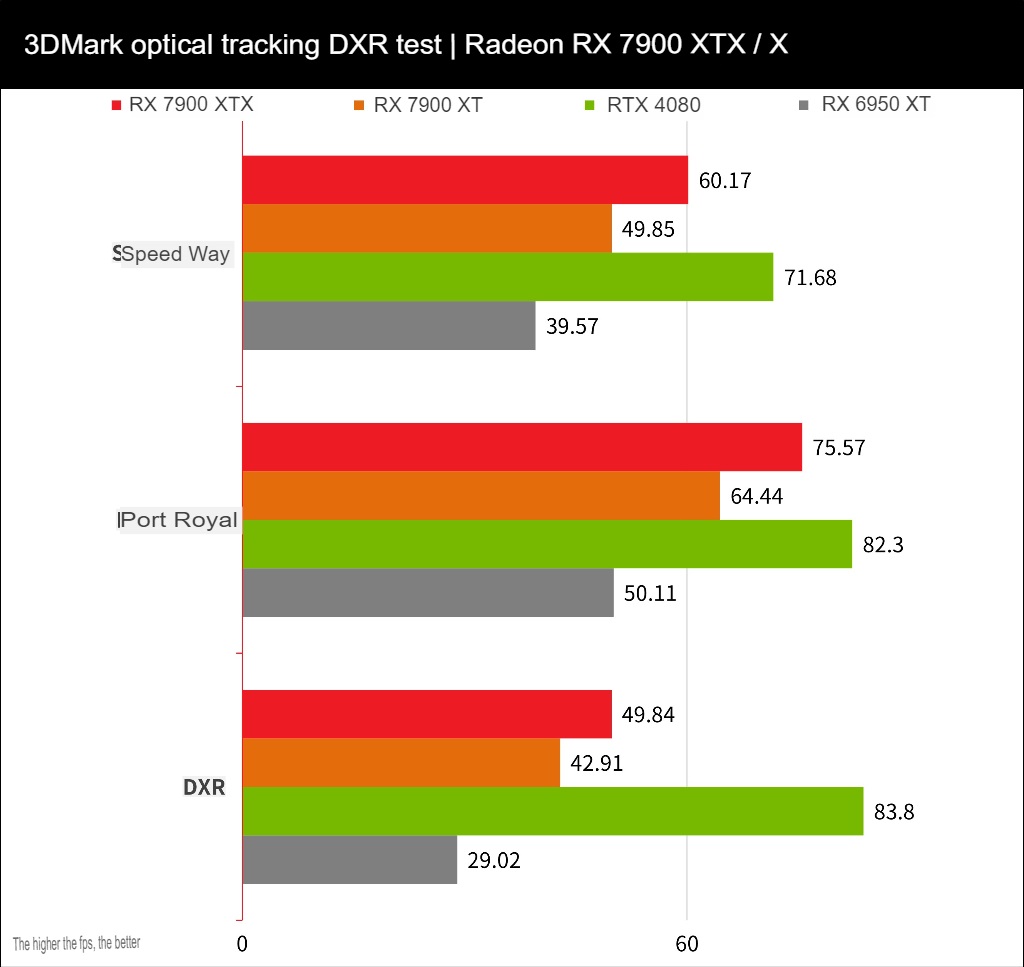
AMD Radeon RX 7900 XTX and RX 7900 XT – 4 e-sports games performance test
4 e-sports games “Rainbow Six: Siege”, “League of Legends”, “APEX Legends” and “CS:GO”, etc., are all Focus on skills, team tactical competitive shooting, and DOTA-type games, so when the game quality and details are not high, the game FPS is also an average performance of more than 100 frames. The test was conducted at 2160p, 1440p, and the highest setting for special effects.
For e-sports games, the RX 7900 XTX can achieve an average of 349.9 FPS in 4K and 463 FPS in 2K, while the RX 7900 XT can achieve an average of 317 FPS in 4K and 445 FPS in 2K, allowing players who love e-sports games to have a very high Screen refresh rate.
RX 7900 XTX outperforms RTX 4080 by about 3% in 4K e-sports games but loses 1% in 2K resolution; but in this project, RX 7900 XTX and RX 7900 XT have improved performance compared to the previous generation RX 6950 XT Only as much as 4%-5%.
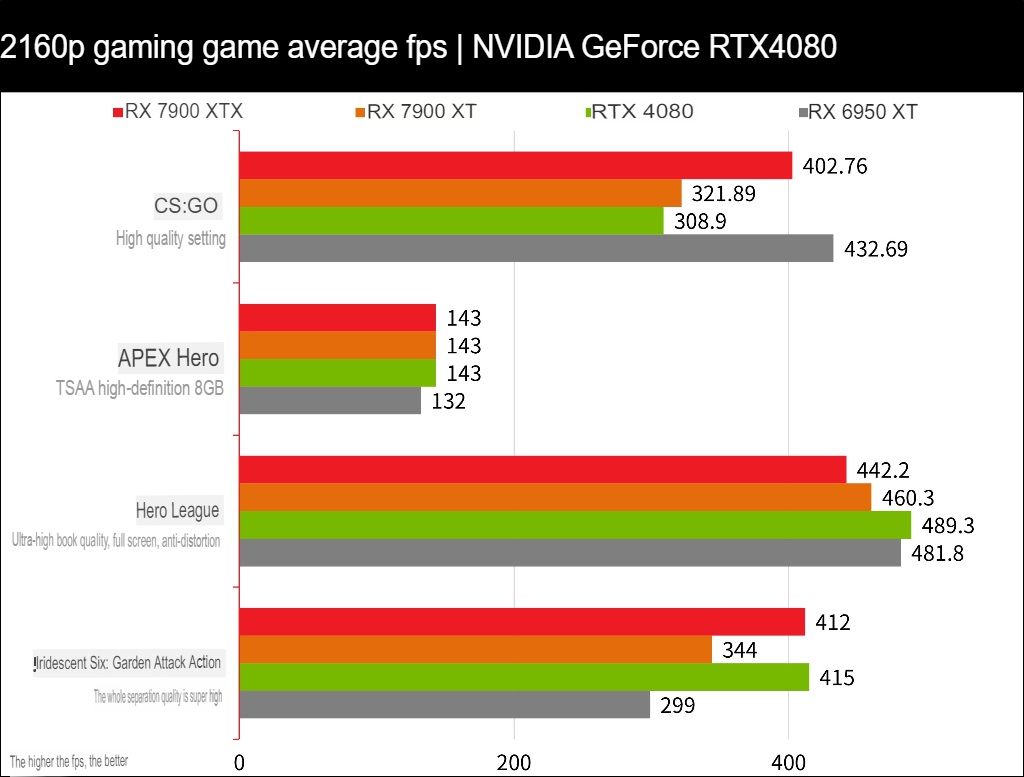
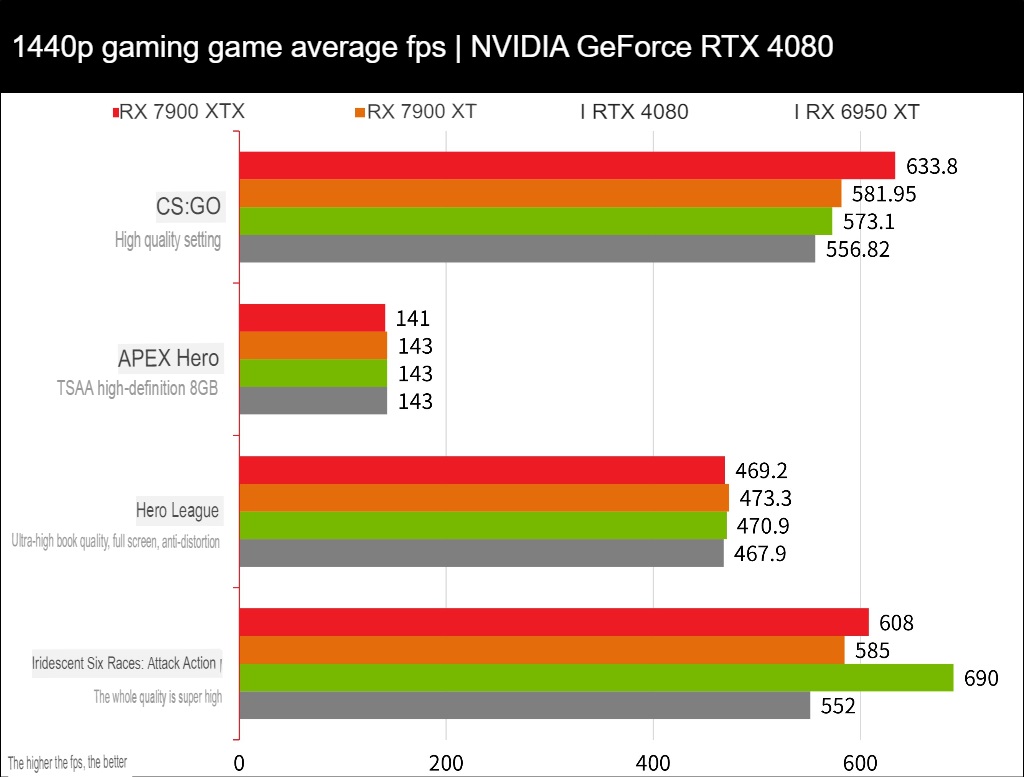
AMD Radeon RX 7900 XTX and RX 7900 XT – 11 game performance tests
11 AAA games are also tested at 2160p, 1440p, and full special effects. This test only uses the ray tracking function in F1 2021, and the rest of the games have no ray tracking, and no DLSS Accelerated to test the GPU’s actual traditional rendering game performance.
The game test list includes the entry-level “F1 2021”, “Forza Horizon 5” racing game, “Tomb Raider: Shadow”, movie game “Death Stranding”, “Gears of War 5”, “The Division 2″, ” Horizon: Waiting for Dawn, as well as tests such as “Borderland 3”, “Assassin’s Creed: Viking Age”, “Blood Killing 2” and “God of War” that are heavy on performance.
The RX 7900 XTX reached an average of 118.2 FPS in 2160p, AAA games, and the RX 7900 XT was 99.1 FPS. The RX 7900 XTX has a 3% performance lead over the RTX 4080. Compared with the previous generation RX 6950 XT, the RX 7900 XTX and RX 7900 XT have 31% and 10% performance improvements.
Then at 1440p resolution, the RX 7900 XTX averaged 183.8 FPS, and the RX 7900 XT averaged 164 FPS, but both lost to the RTX 4080 with an average of 187.8 FPS.
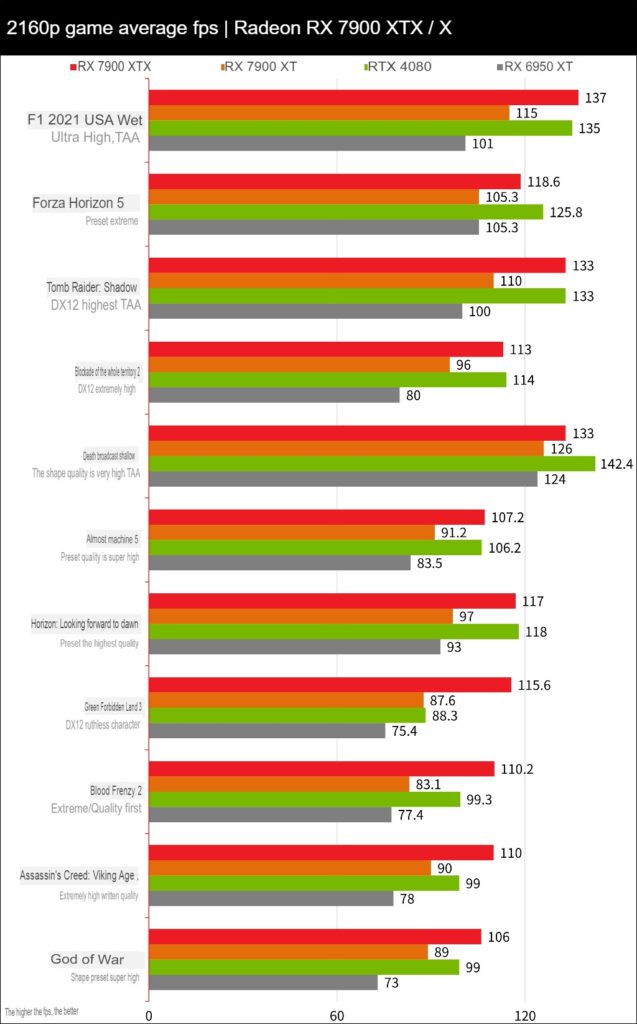
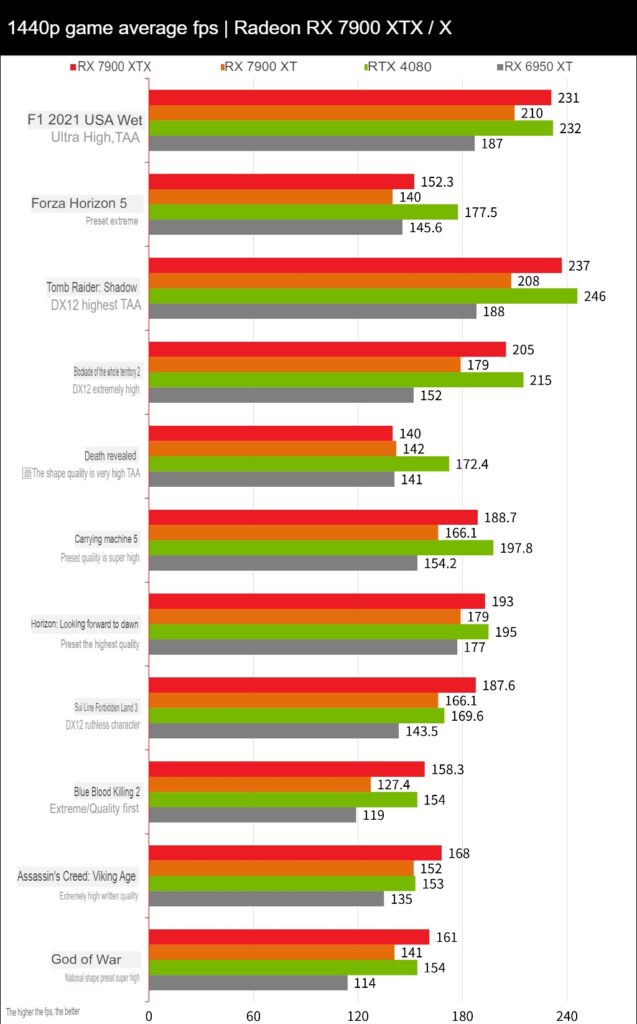
AMD Radeon RX 7900 XTX and RX 7900 XT – 8 light-chasing game tests
8 light-chasing DXR game tests, using the most popular “Dian Yu Ren Ke 2077”, “Control”, “Watch Dogs: Free Legion”, Games such as “F1® 22”, “Marvel Spider-Man Remastered”, “Marvel Interstellar”, “Evil Castle Village” and “Far Cry 6” were tested. Test 2160P, 1440p resolution, and the highest settings of special effects/ray tracing, FSR and DLSS acceleration will also be enabled. Please refer to the chart for detailed settings.
The RX 7900 XTX achieved an average of 106.9 FPS in 2160p and DXR games, and the RX 7900 XT averaged 92.5 FPS. It’s just that the performance in “Dian Yu Ren Ke 2077” is still not enough to experience the game smoothly, but it can also have good performance in games such as “Evil Castle Village”, “Far Cry 6”, and “F1® 22”.
Compared with the previous generation RX 6950 XT, RX 7900 XTX and RX 7900 XT have 38% and 19% improvement in 4K ray tracing performance, respectively; but if compared with RTX 4080 ray tracing, they lose -18% and -29%.
If AMD players want to play “Dian Yu Ren Ke 2077”, it is recommended to reduce the resolution to 1440p, to have sufficient FPS performance.
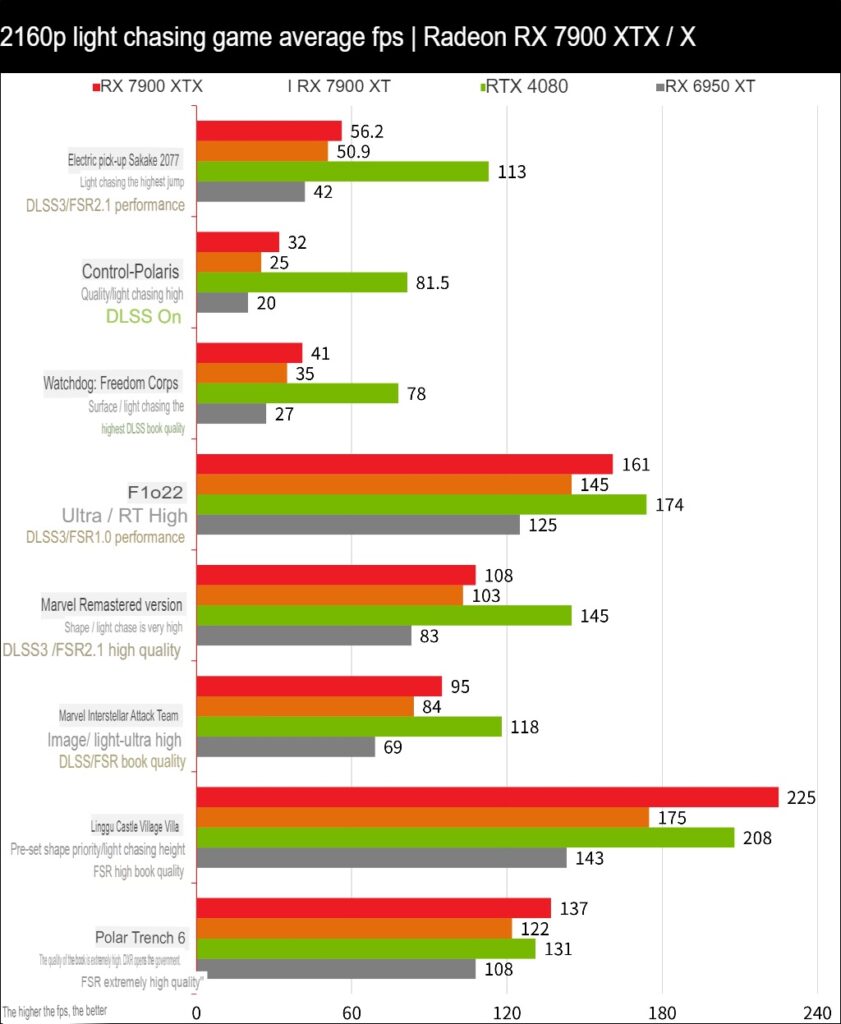
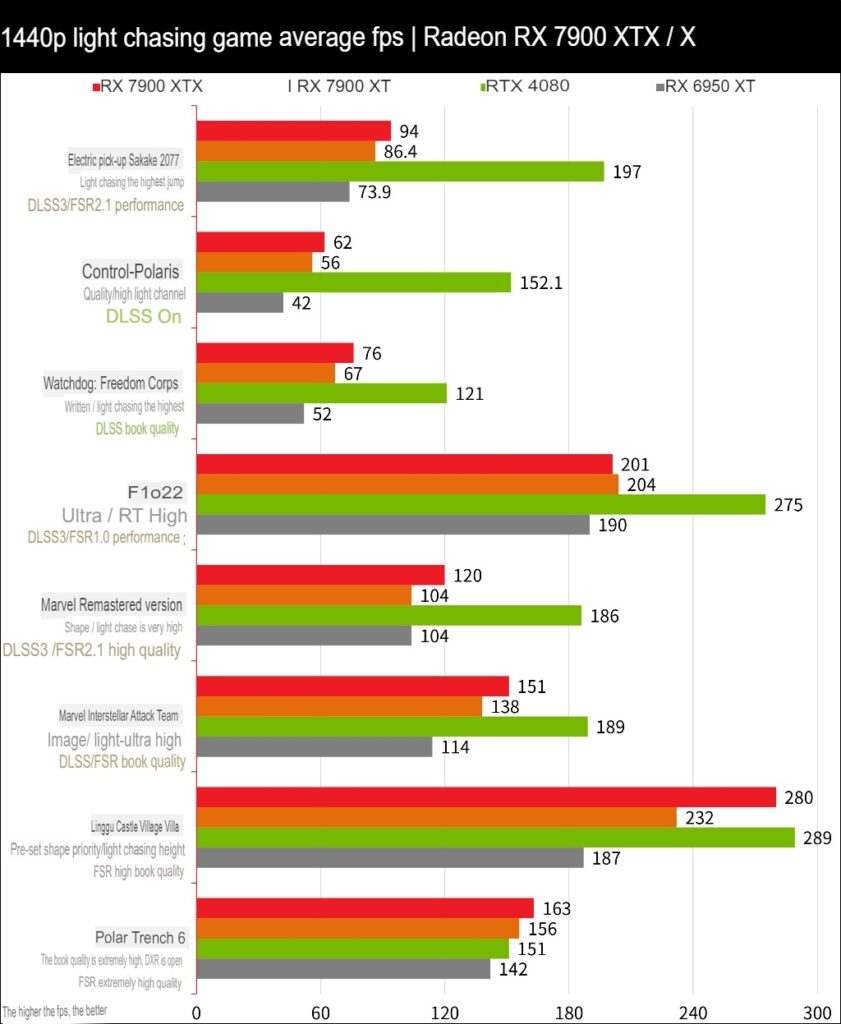
AMD Radeon RX 7900 XTX and RX 7900 XT Power Consumption and Temperature Measurements
The graphics card’s power consumption and temperature test are tested using the Time Spy Stress test, FurMark and “Dian Yu Ren Ke 2077”. When measuring power consumption, use the PACT tool provided by NVIDIA to monitor the wattage provided by the PCIe slot and the power supply 12V.
Regarding graphics card temperature, RX 7900 XTX has a maximum temperature of 66-69°C, and RX 7900 XT has a temperature of 56-59°C. The overall temperature is better than the 75°C of the previous generation RX 6950 XT self-made card and is comparable to the ultra-large card. RTX 4080 Founder Edition has comparable thermal performance.
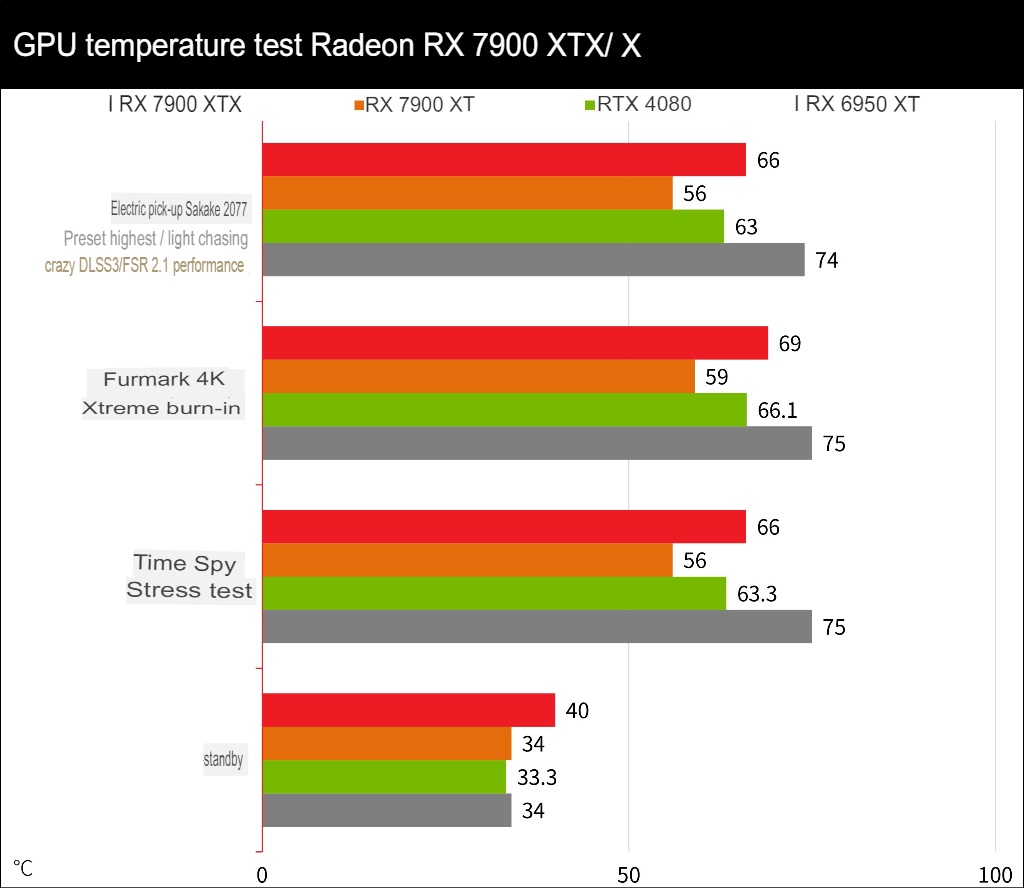
In the TBP power consumption test of the graphics card, in the 2077 game, the RX 7900 XTX reaches 352W, and the RX 7900 XT reaches 310W, both of which are higher than the 280W of the RTX 4080. The performance of power consumption does have a good result.
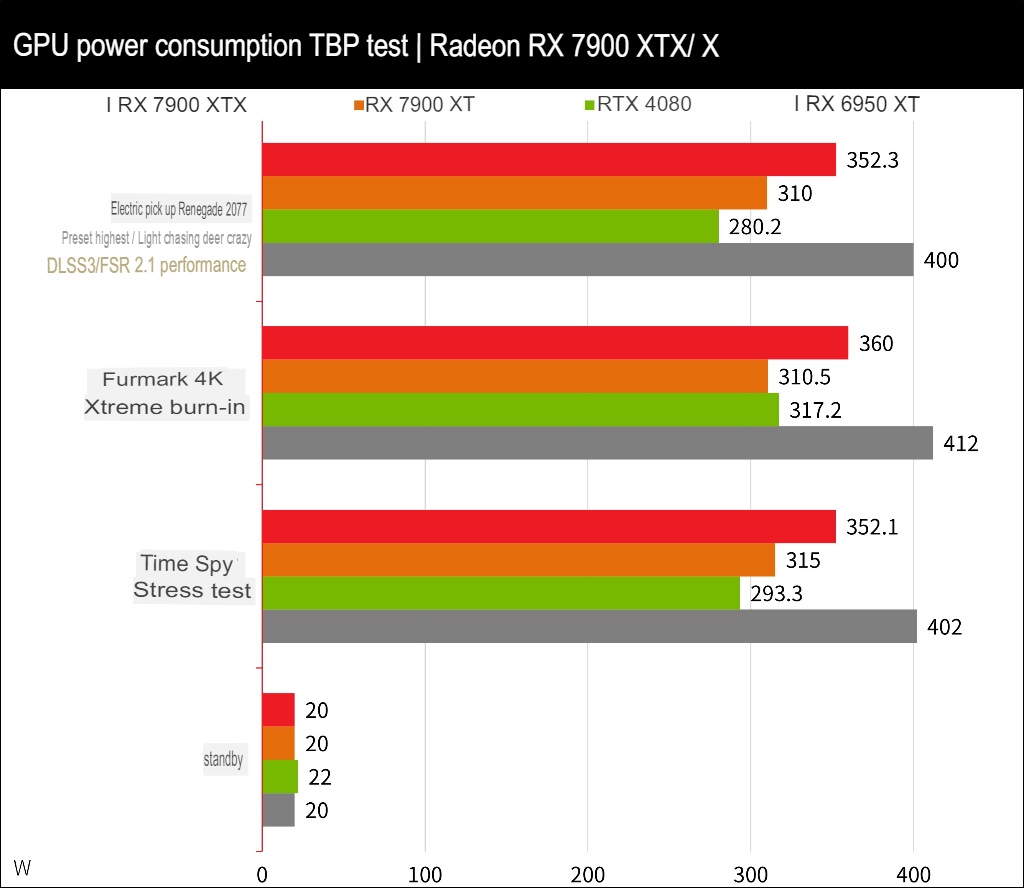
Summary
Unexpectedly, under the RDNA 3 architecture and Chiplet small chip package, AMD made the RX 7900 XTX the dream of 4K and 100 FPS. It beat the RTX 4080 in AAA and e-sports games but still lost to the light-chasing game. Opponents, but it can also allow players to have a better light-chasing game experience.
RX 7900 XTX has an average of 118.2 FPS for AAA games and an average of 106.9 FPS for DXR ray tracing at 4K resolution and high special effects settings, becoming AMD’s first game graphics card to unlock 4K and 100 FPS; as for the RX 7900 XT, it has an average of 99.1 FPS for AAA and 100 FPS for RX 7900 XT. DXR ray tracing averaged 92.5 FPS.
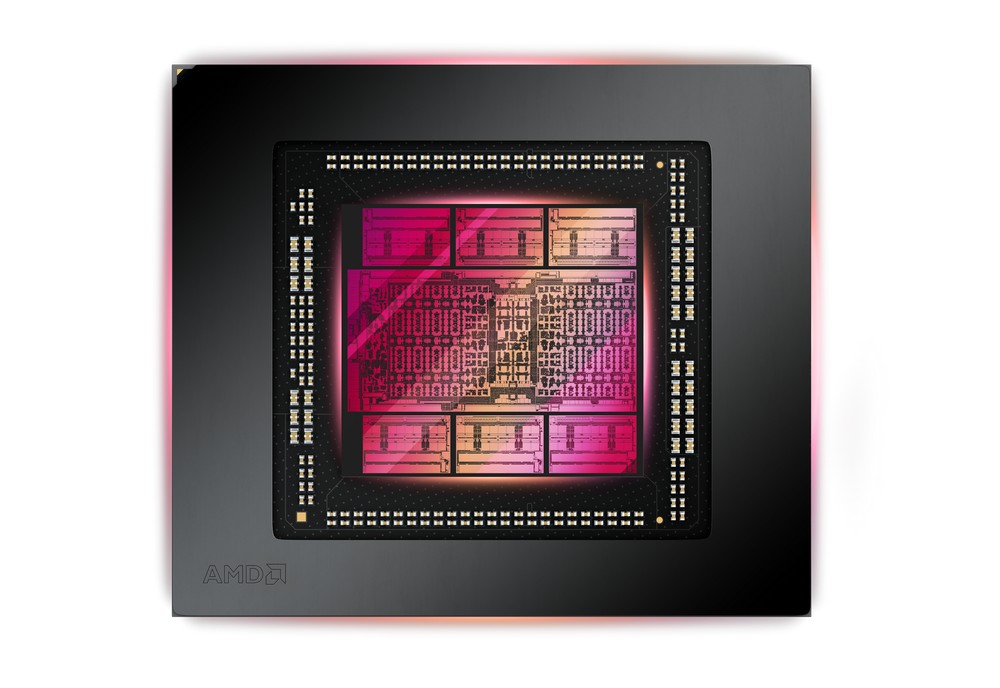
In terms of “performance per watt”, the RX 7900 XTX has 54% more performance than the previous generation, and the RX 7900 XT also has a 47% performance per watt improvement; but compared with the RTX 4080, it loses in performance per watt -23%, -27%, after all, RTX 4080 is indeed lower than RX 7900 series in power consumption test.
As for the “per dollar performance”, RX 7900 XTX and RX 7900 XT are 48% and 41% more cost-effective than the previous generation, respectively, and in AAA and e-sports games, they are also better than RTX 4080. The price/performance ratio of RTX 4080 is better than that of light-chasing games.

Overall, AMD’s current generation of Radeon RX 7900 XTX and RX 7900 XT has a good performance per dollar and per watt. As long as the price in Taiwan can be maintained when it goes on sale tomorrow, it is about 10,000 yuan cheaper than the RTX 4080 self-made card. It is reasonable if the price can be opened at the beginning of 30,000, but if it is close to 40,000, it will be a bit embarrassing.
If the price is reasonable, Radeon RX 7900 XTX is undoubtedly the cheapest 4K, 100 FPS gaming graphics card in the contemporary era. As for the opponent of RX 7900 XT, it is likely to be the RTX 4070 series launched later, which may be around January next year; The expected mainstream and entry-level card updates within 20,000 and 10,000 yuan may not be announced until at least the second half of next year.
If this article is helpful for you, please share this article with your friends on social media. Thank you!!
This article is based on the personality of the reviews. You are responsible for fact-checking if the contents are not facts or accurate.
Title: Take on the future! Test results for the AMD Radeon RX 7900 XTX and RX 7900 XT, plus 4K 100 frames